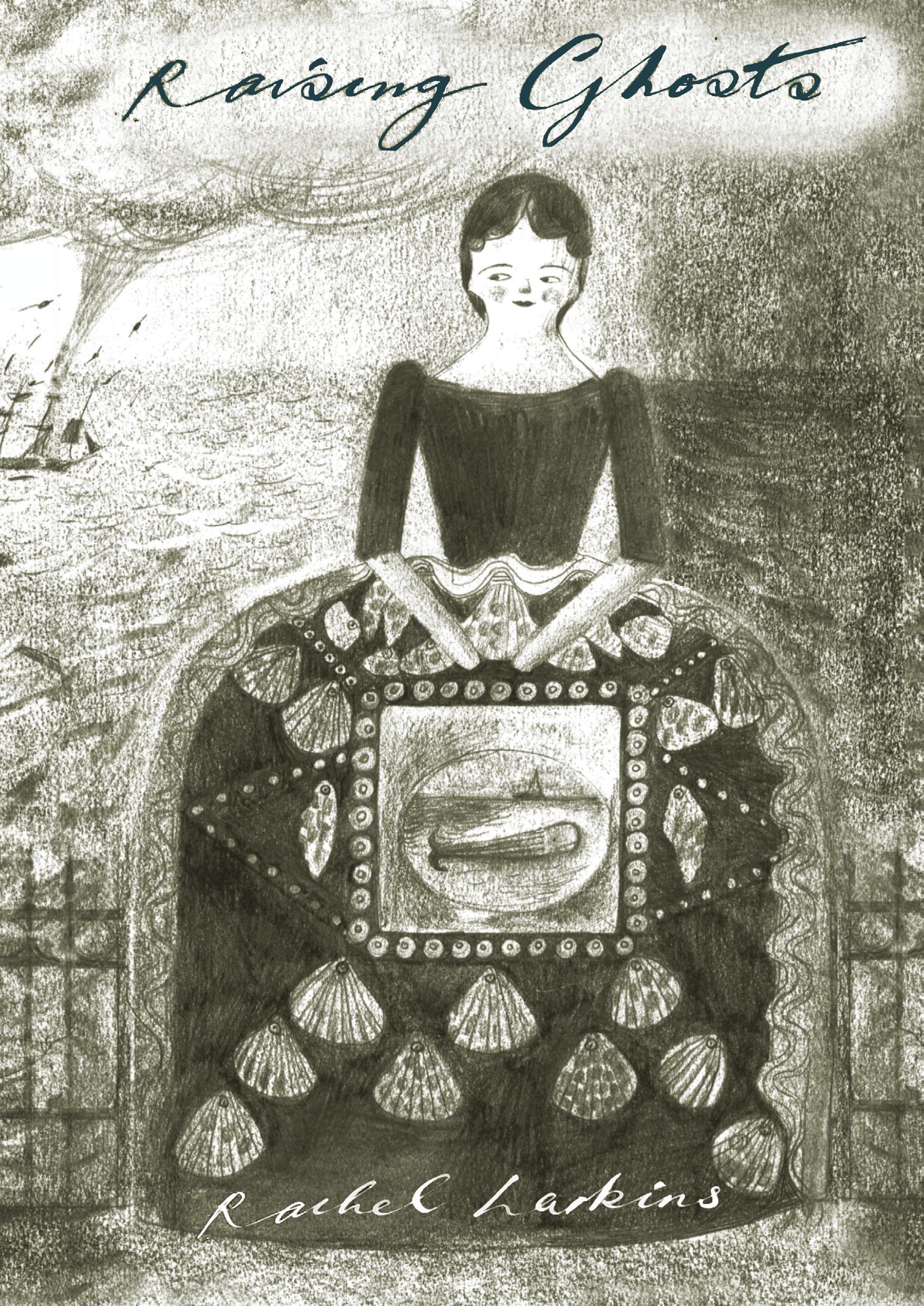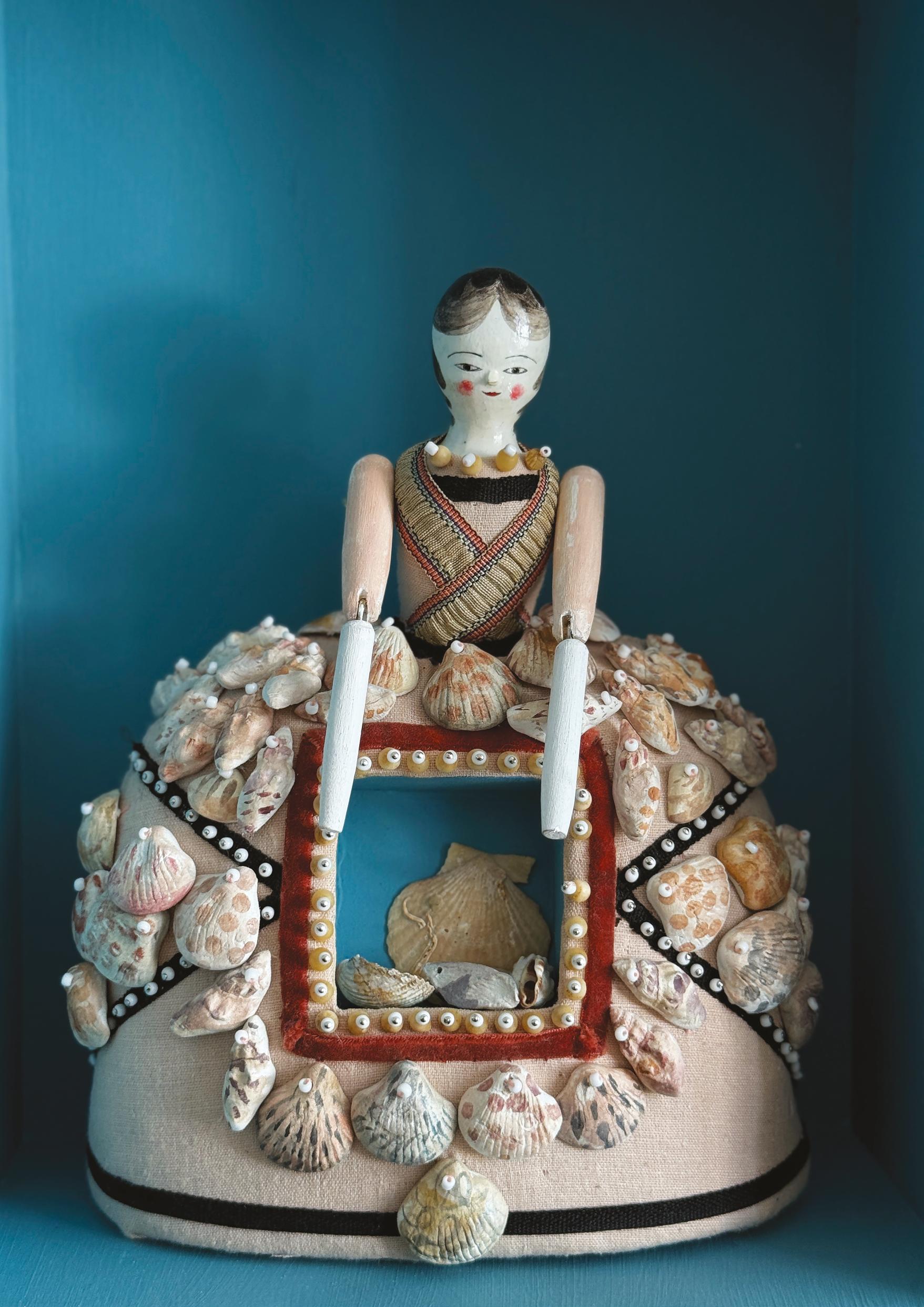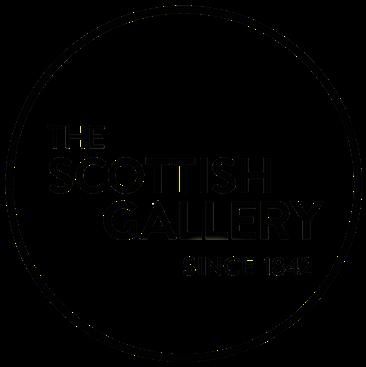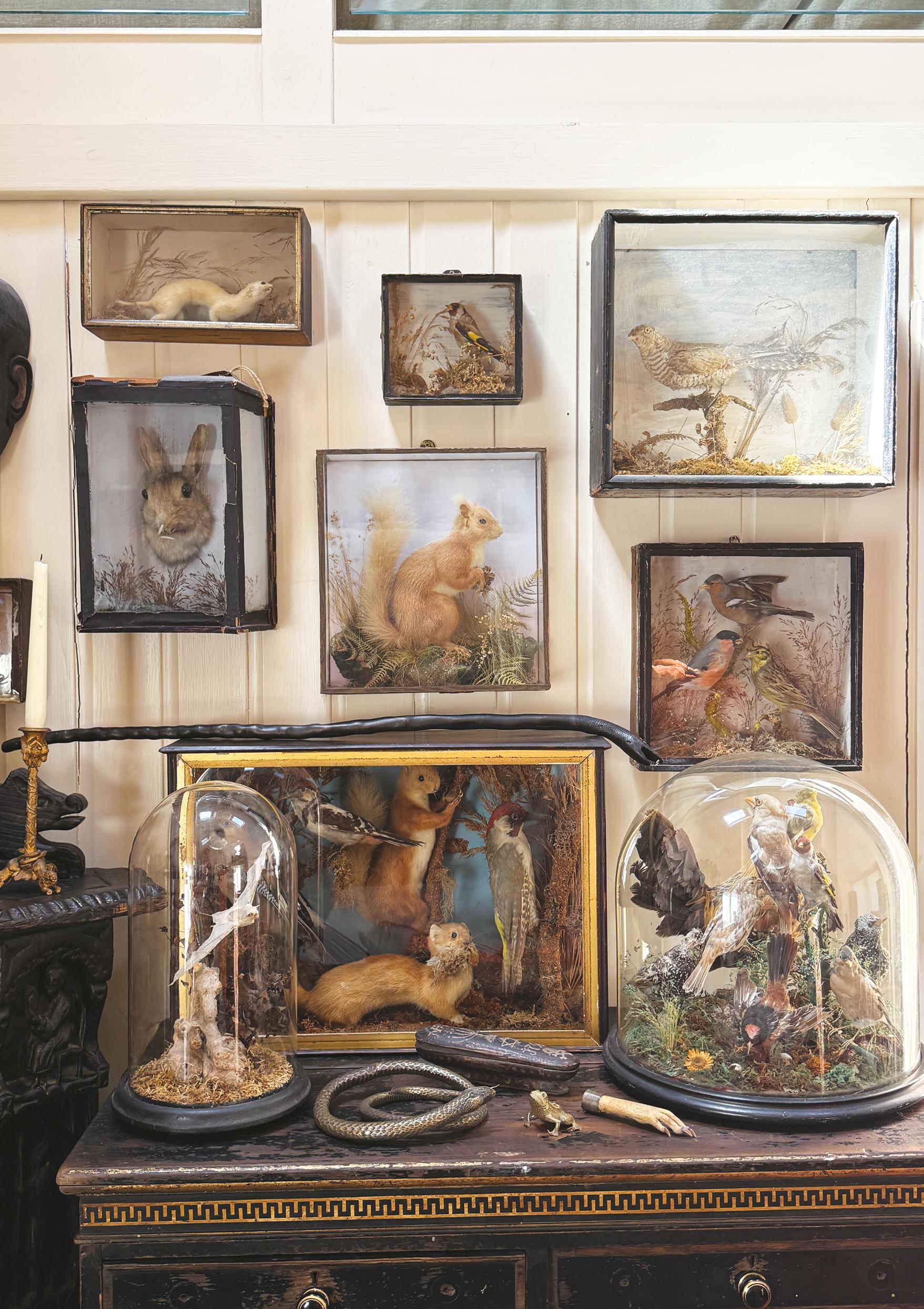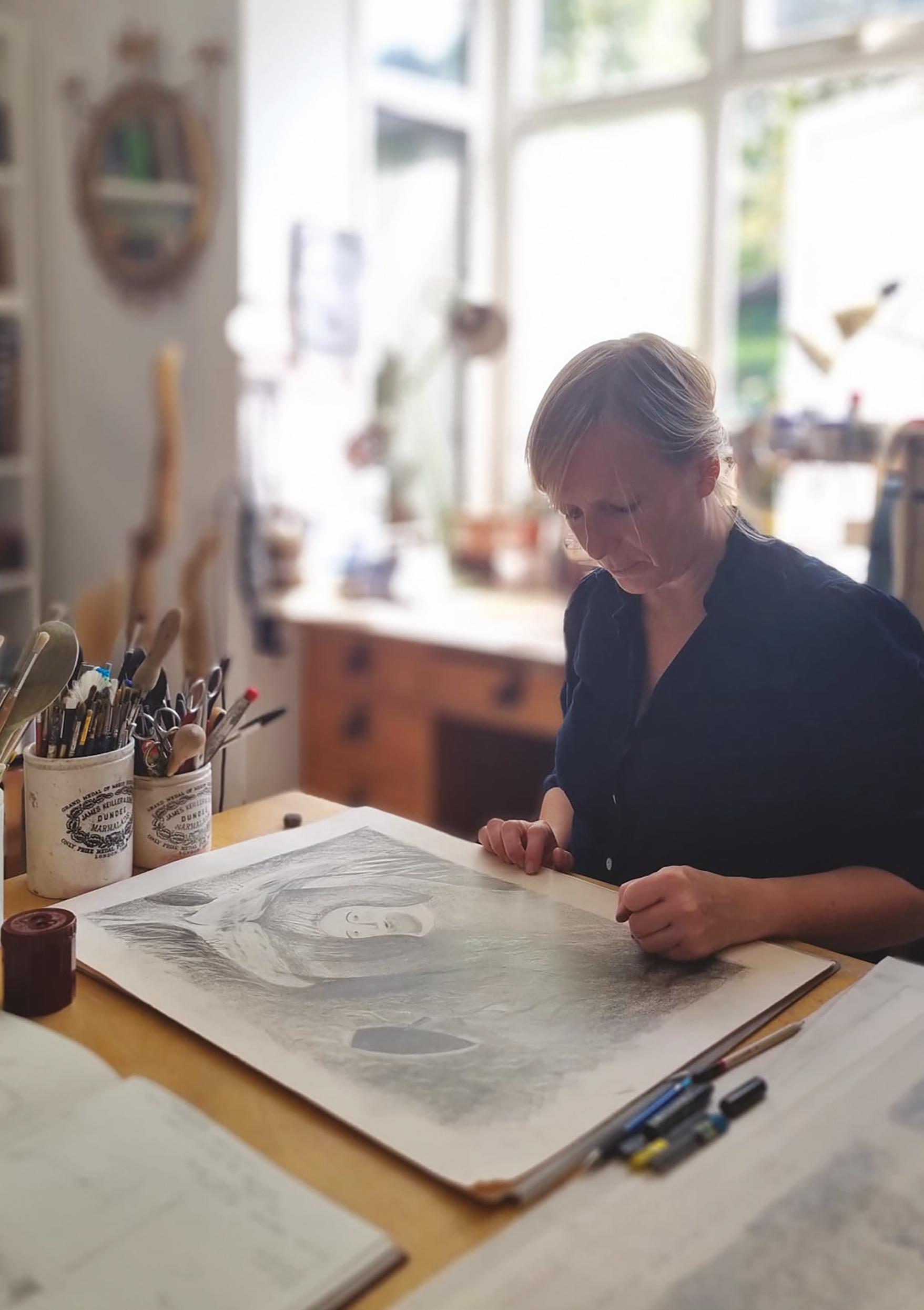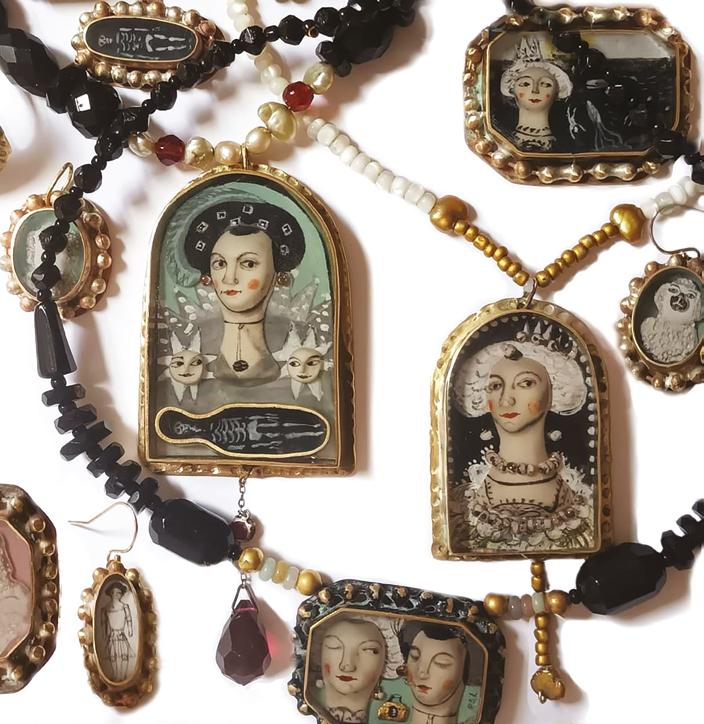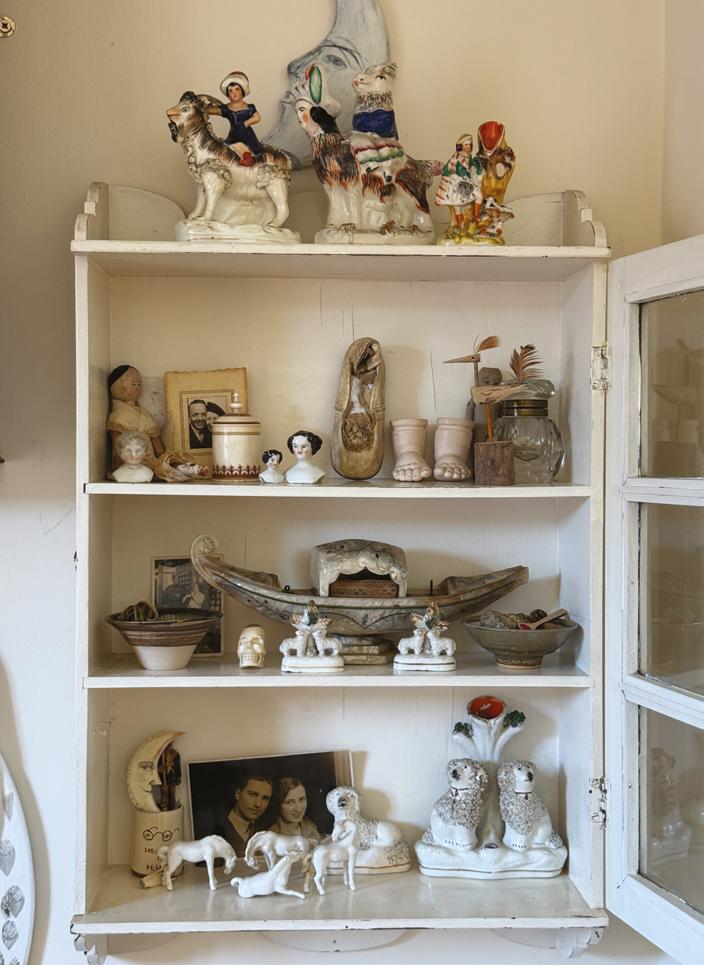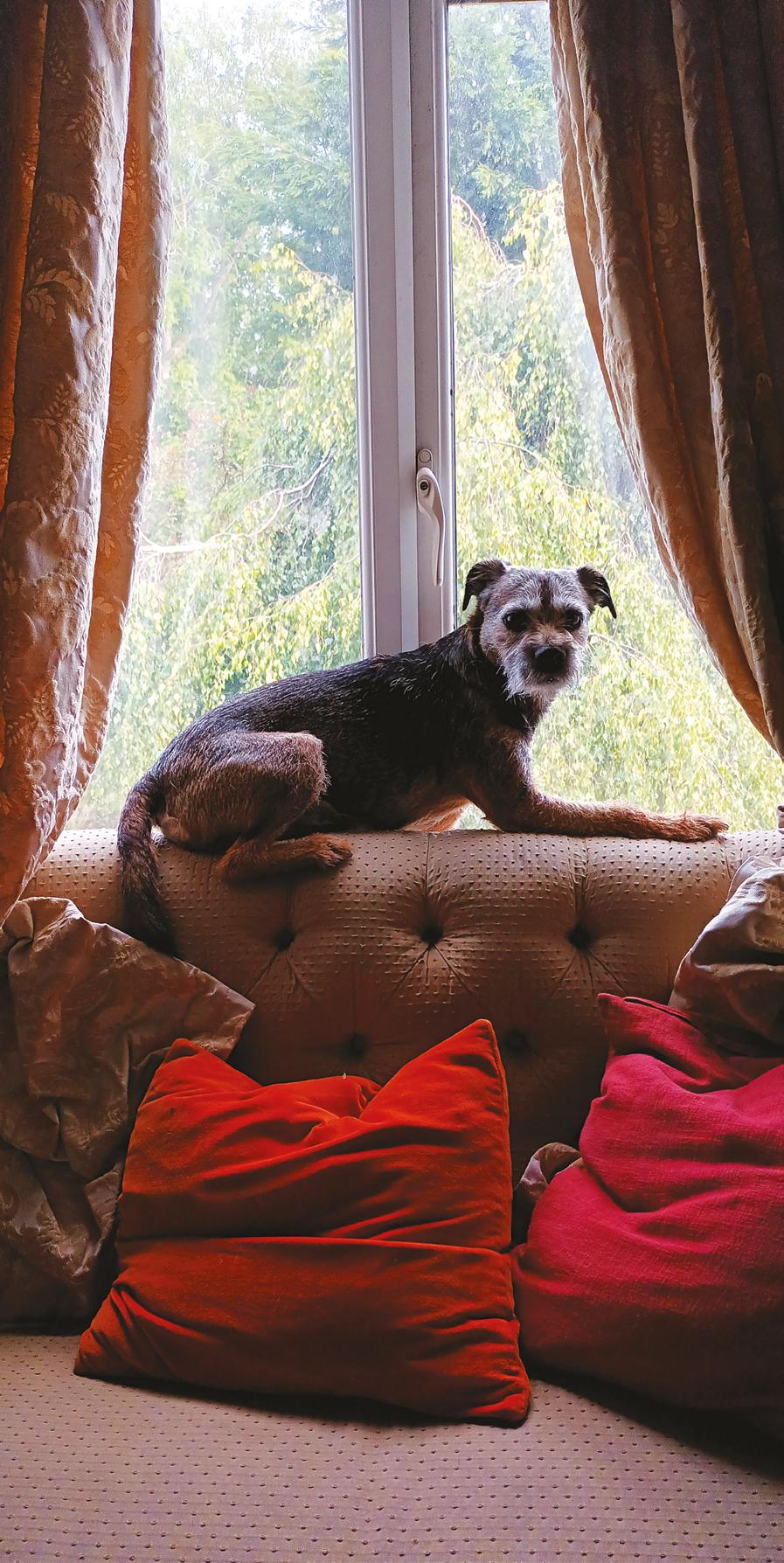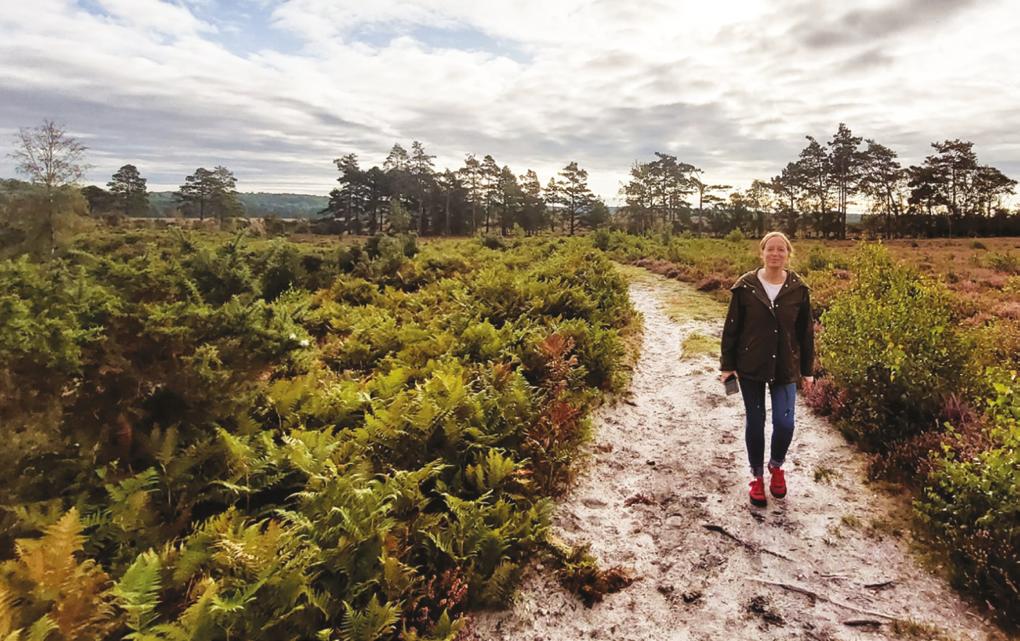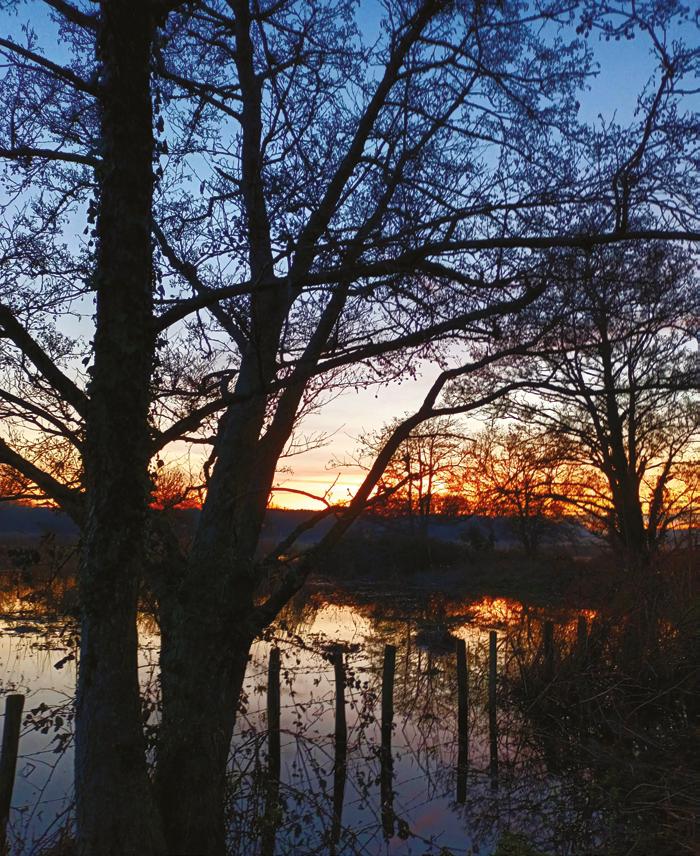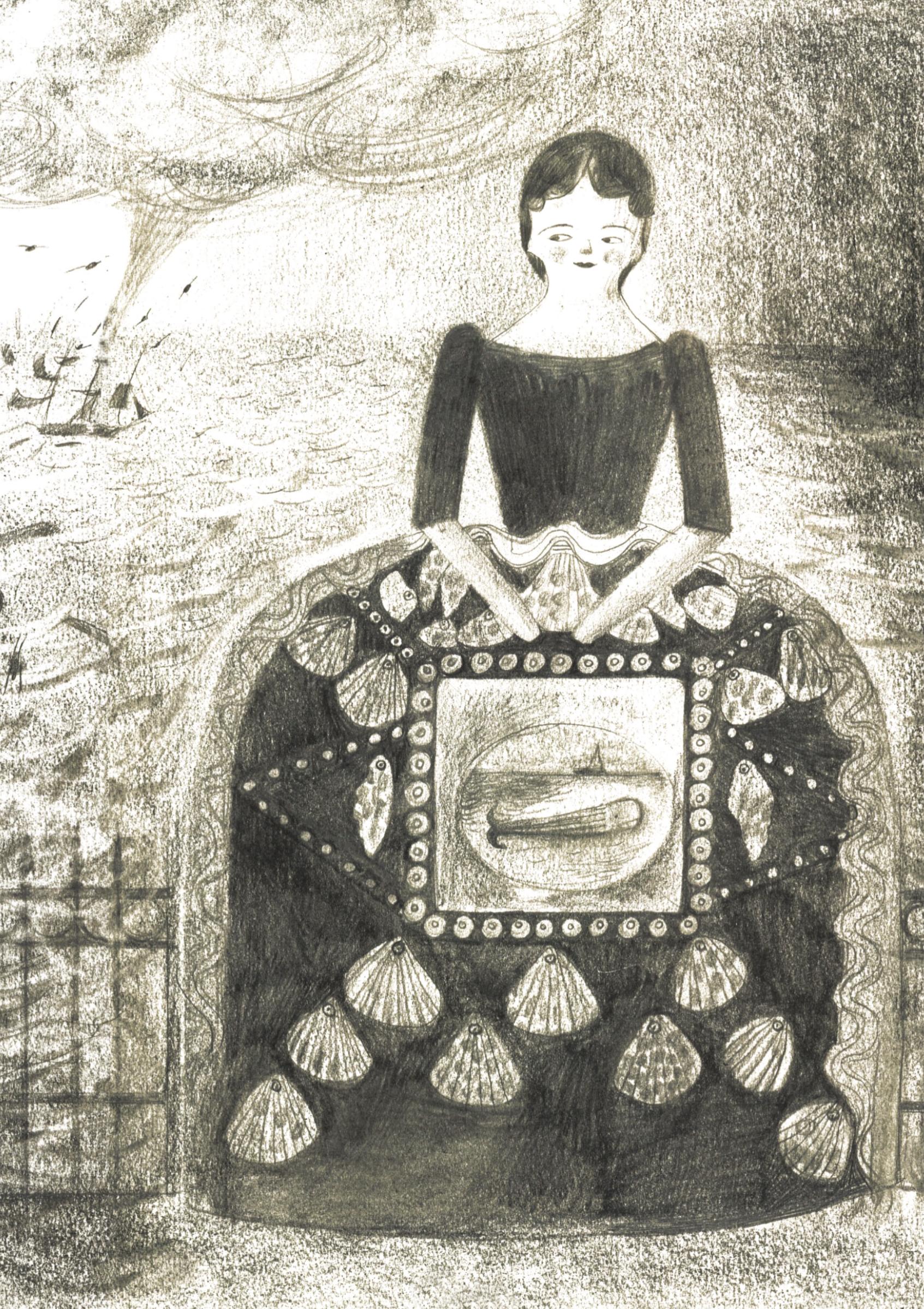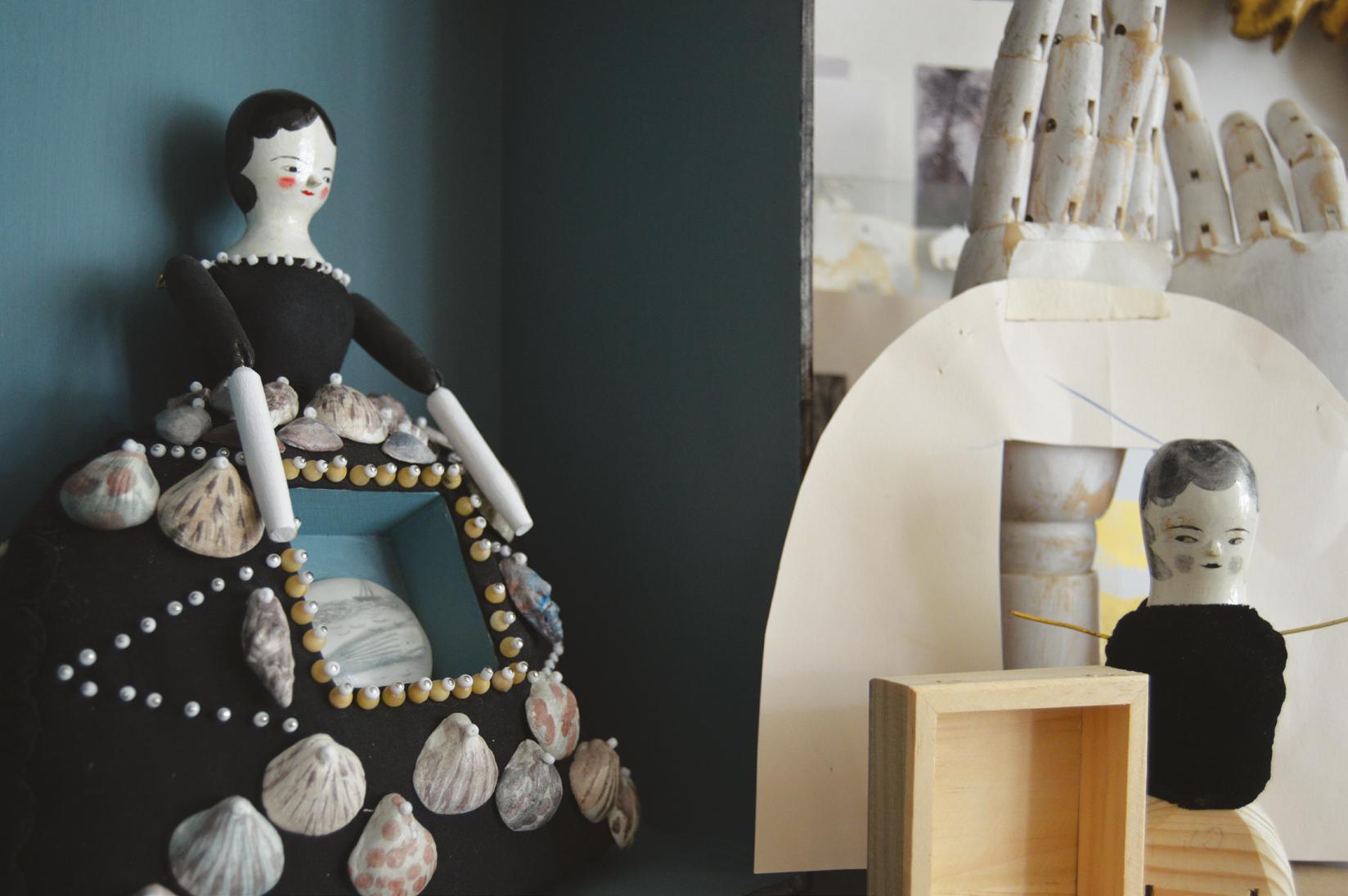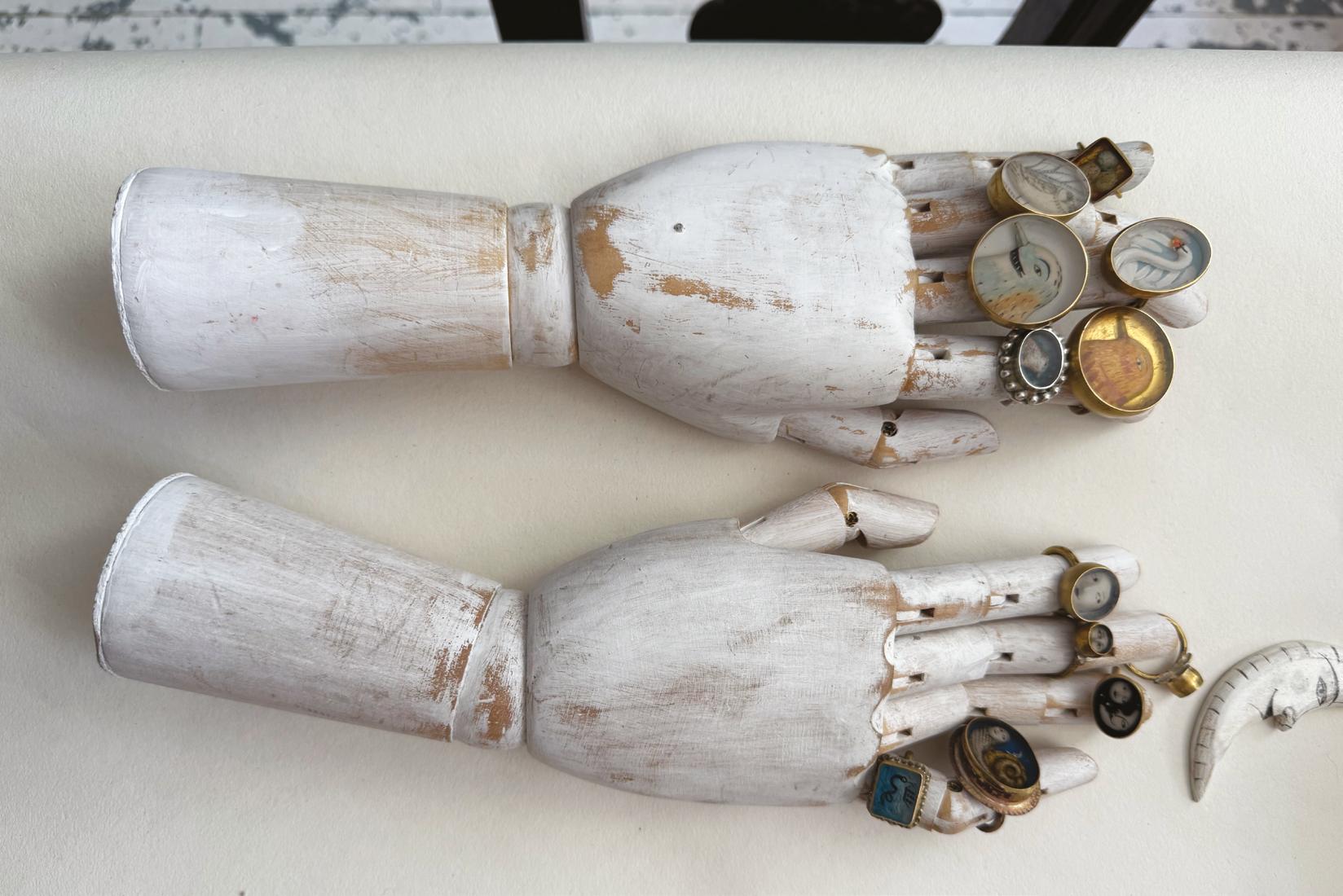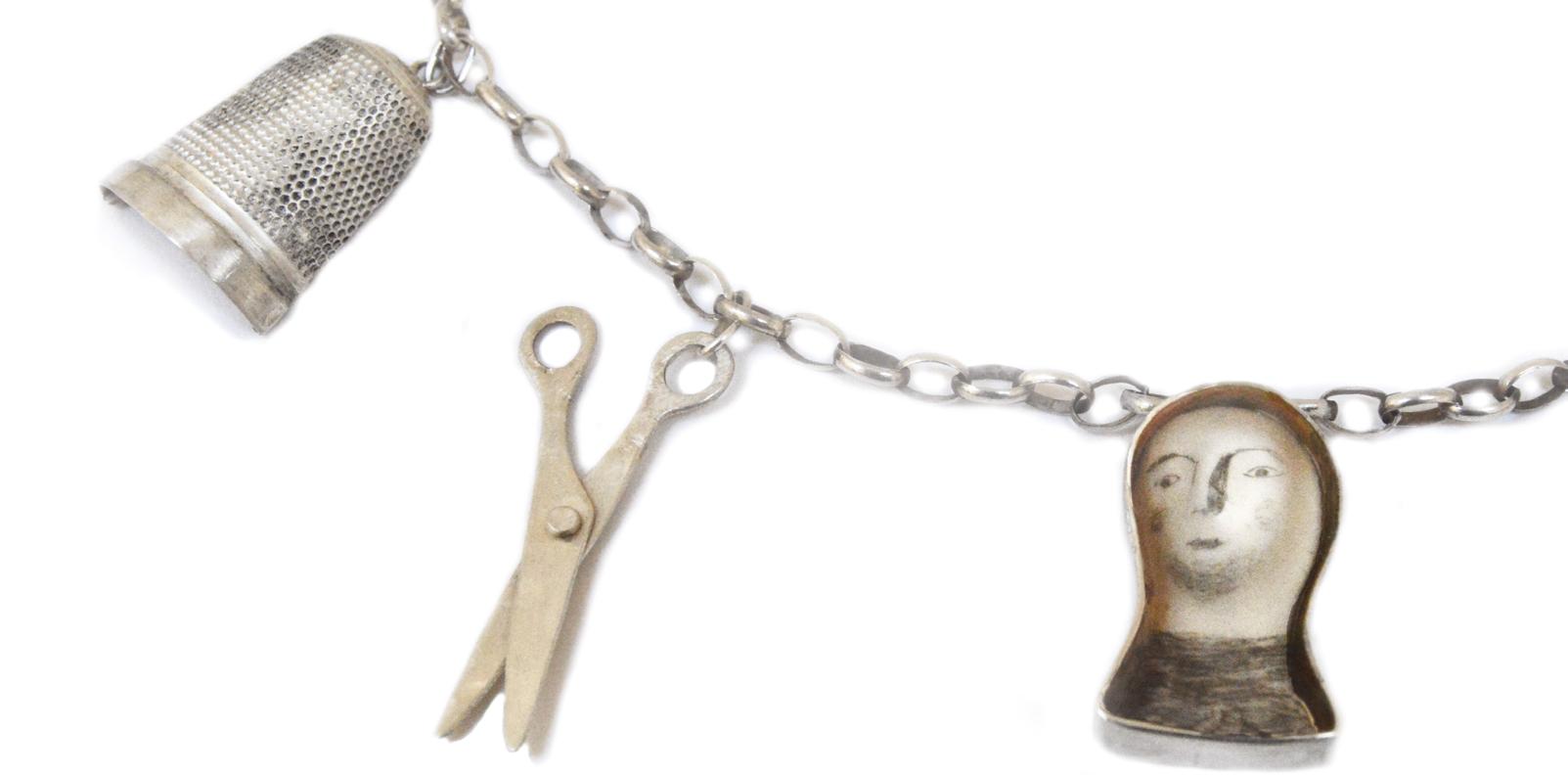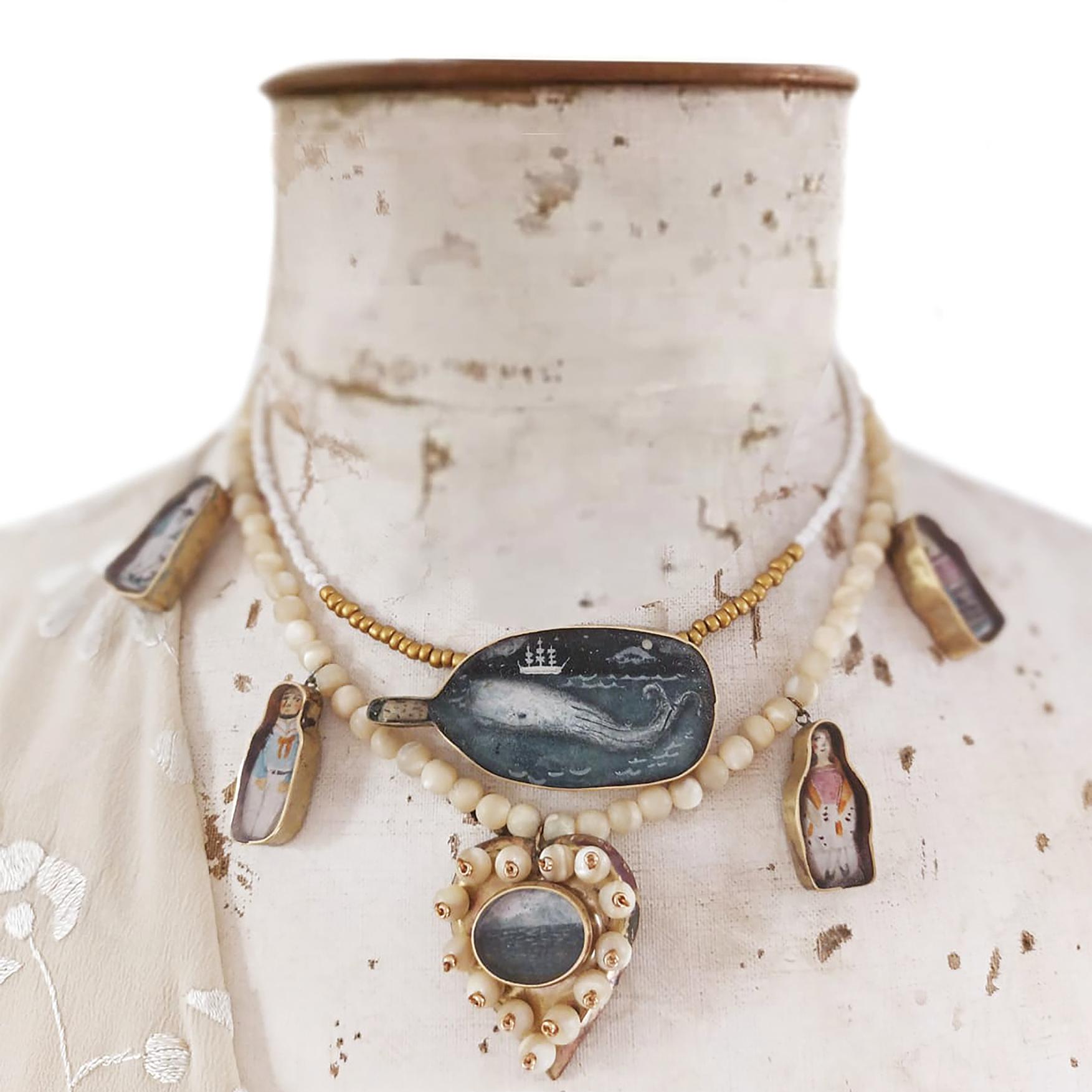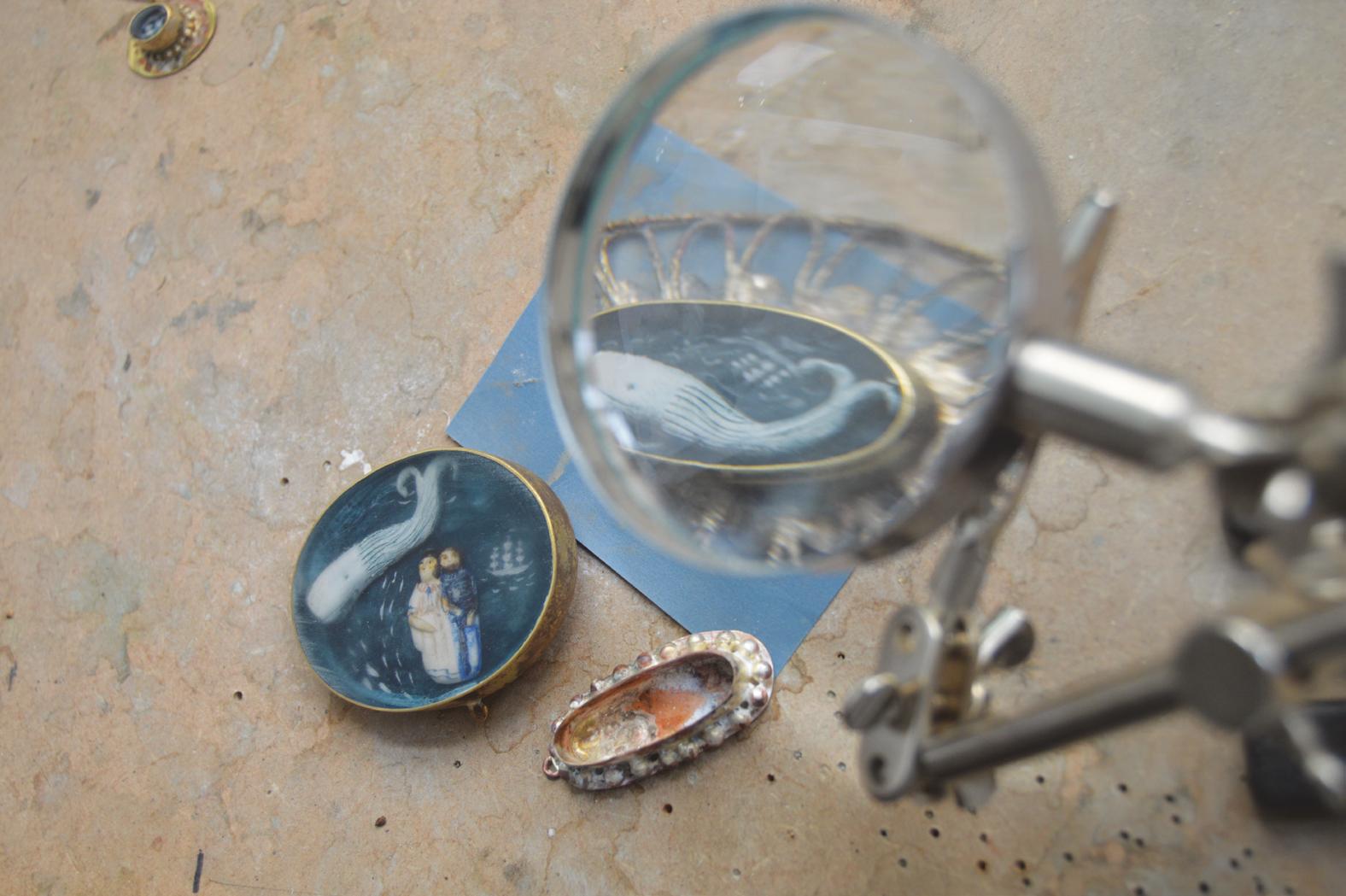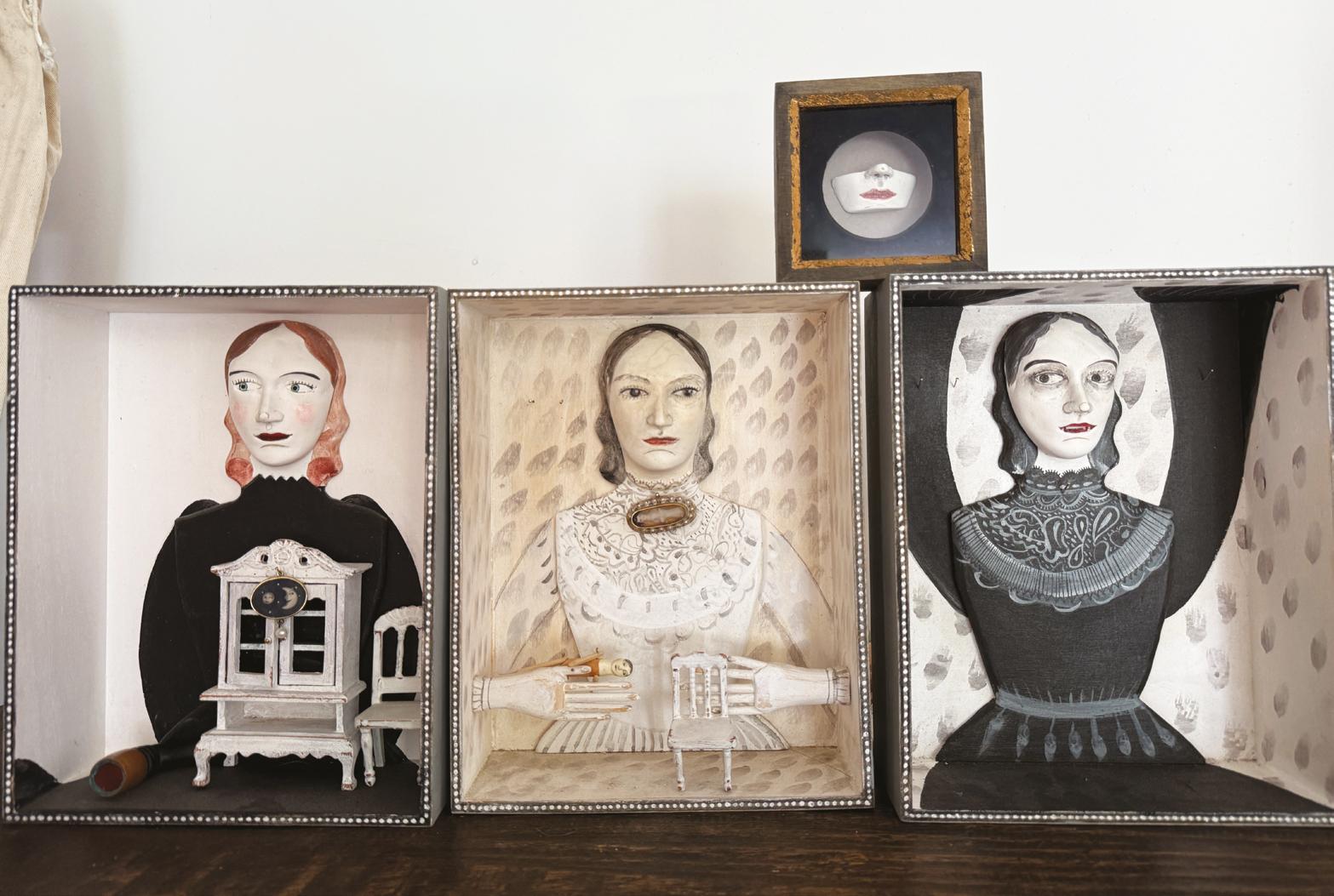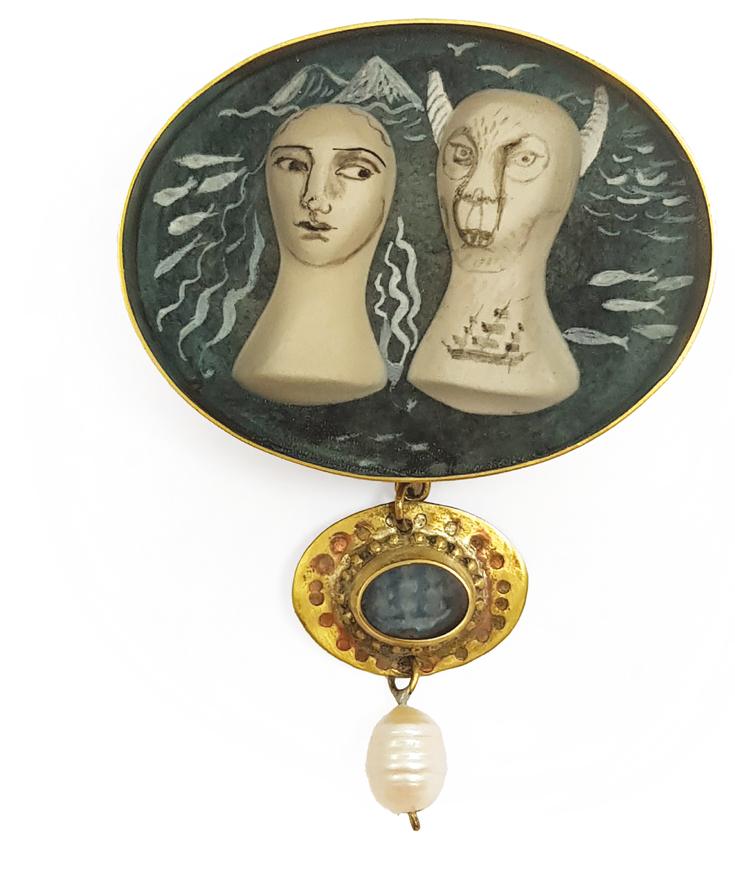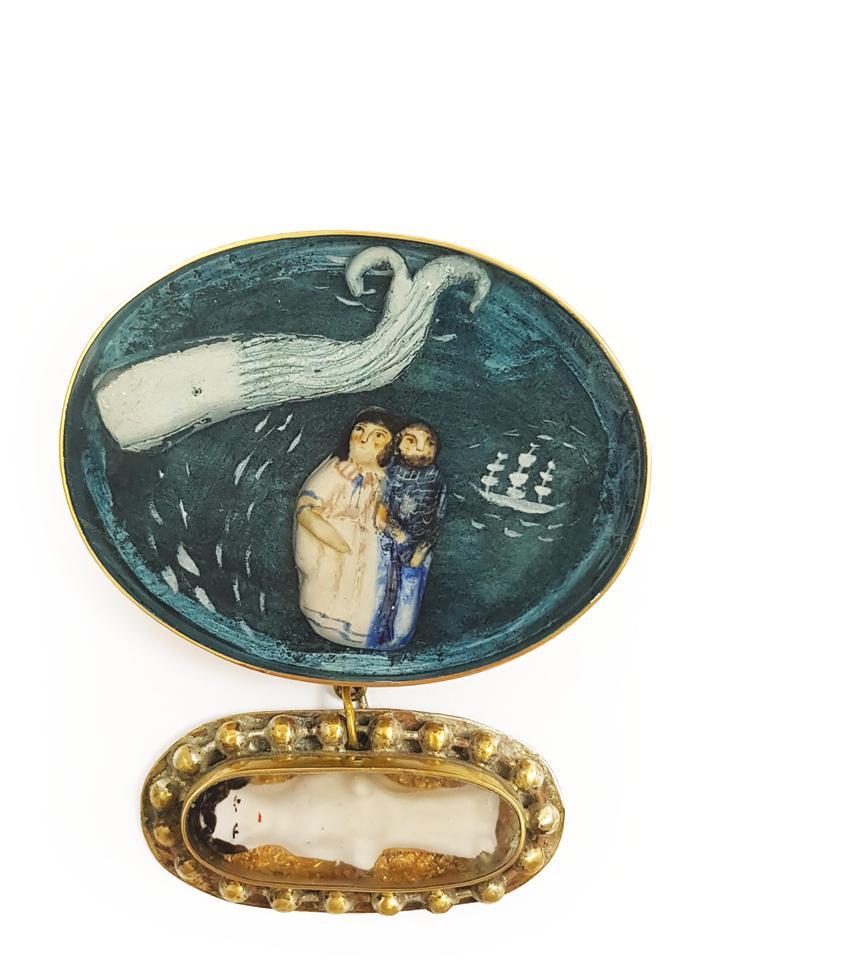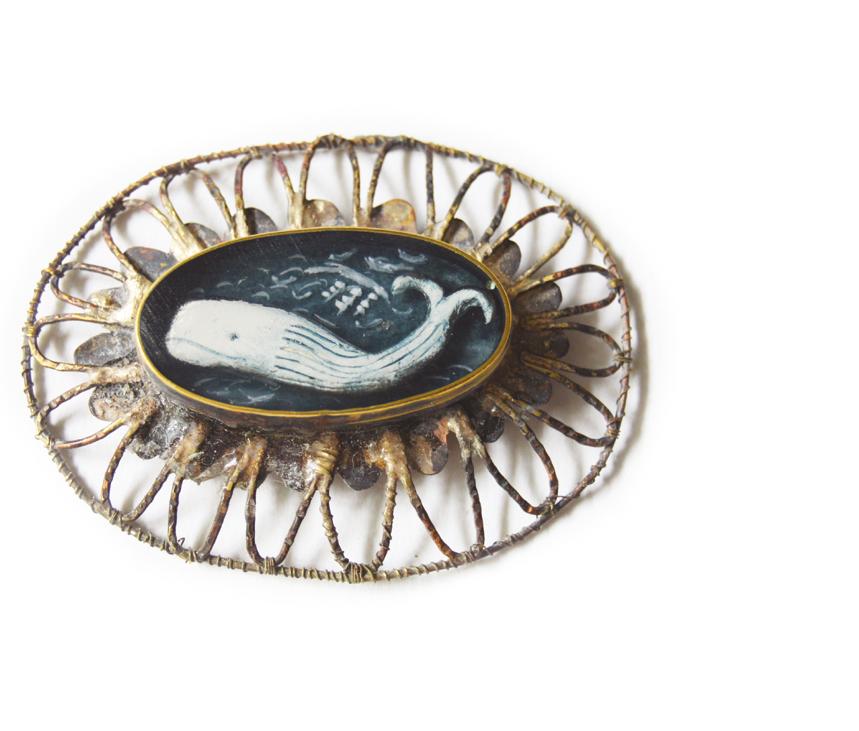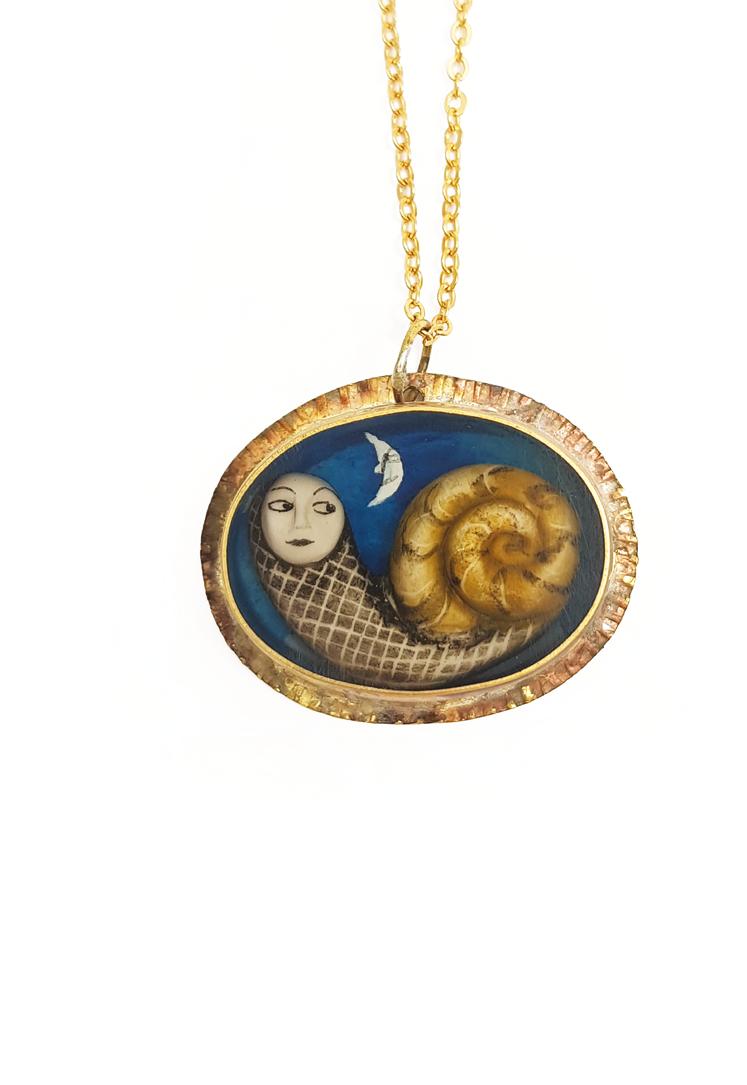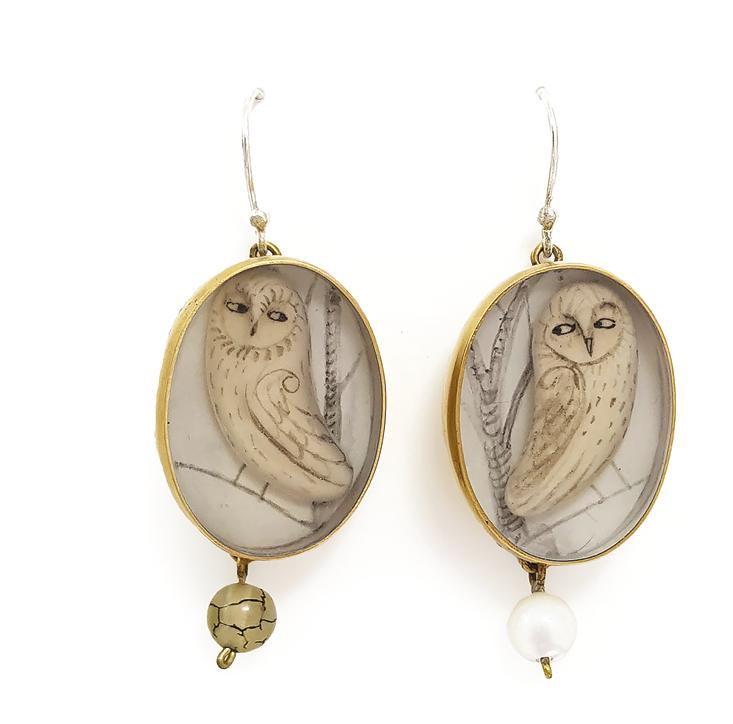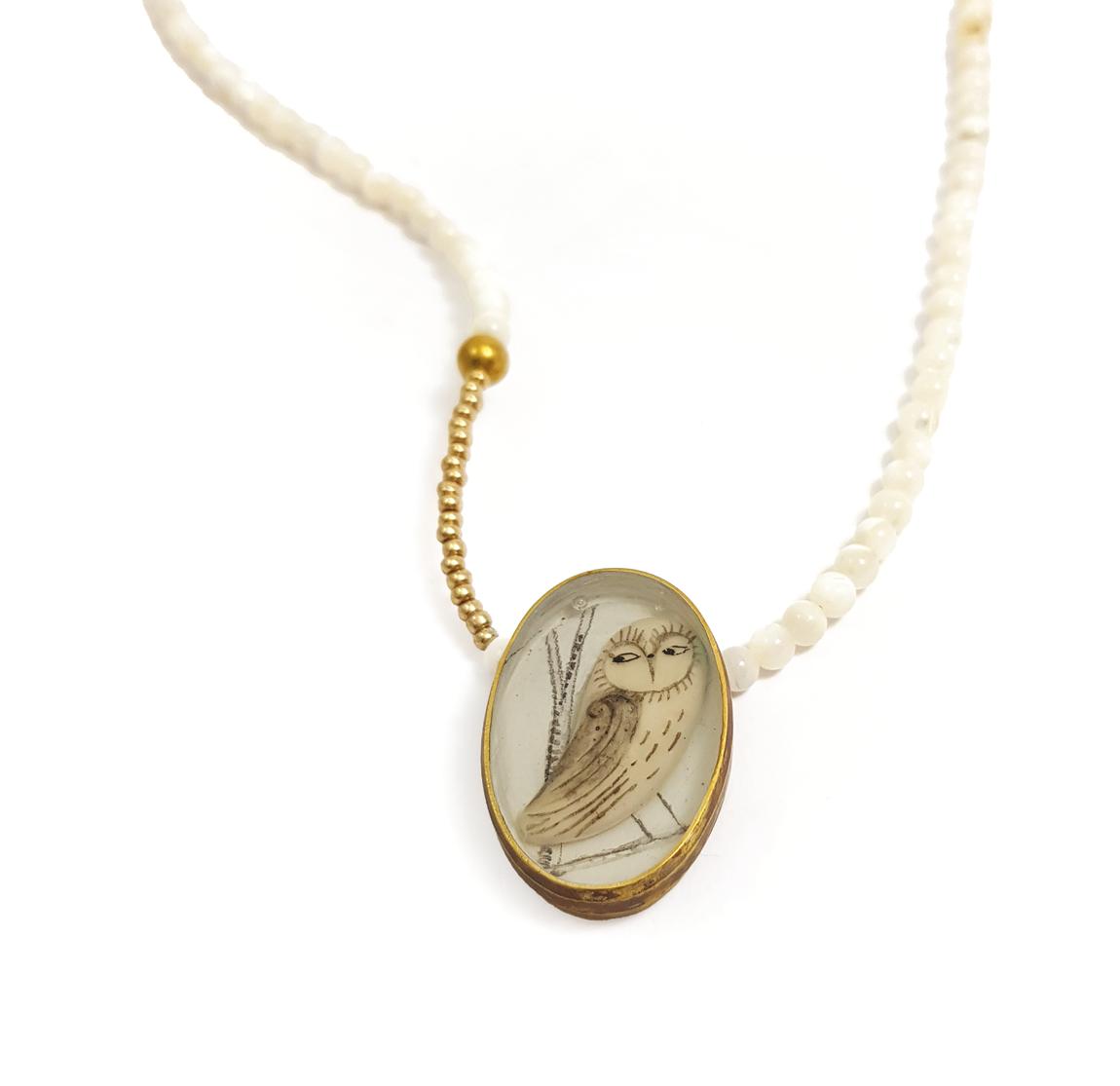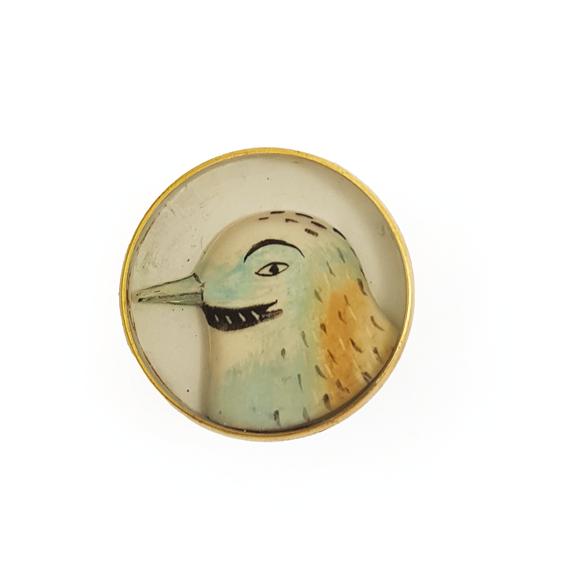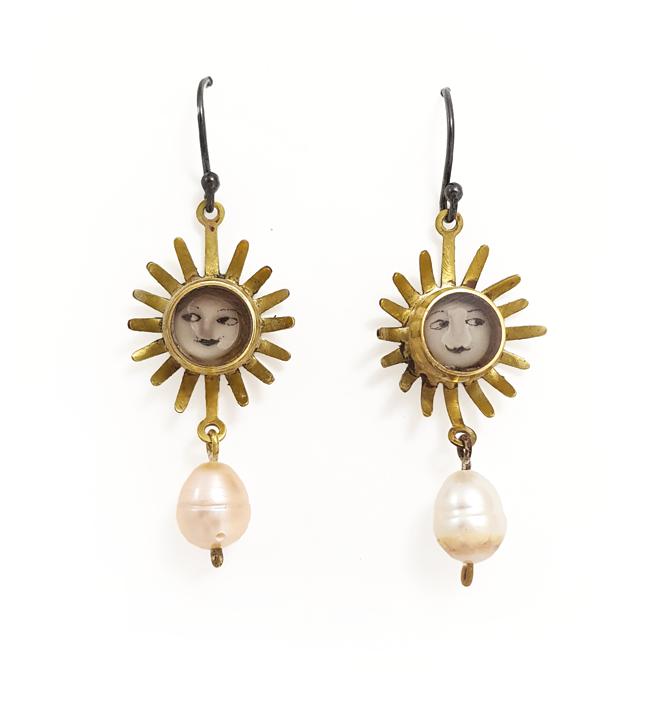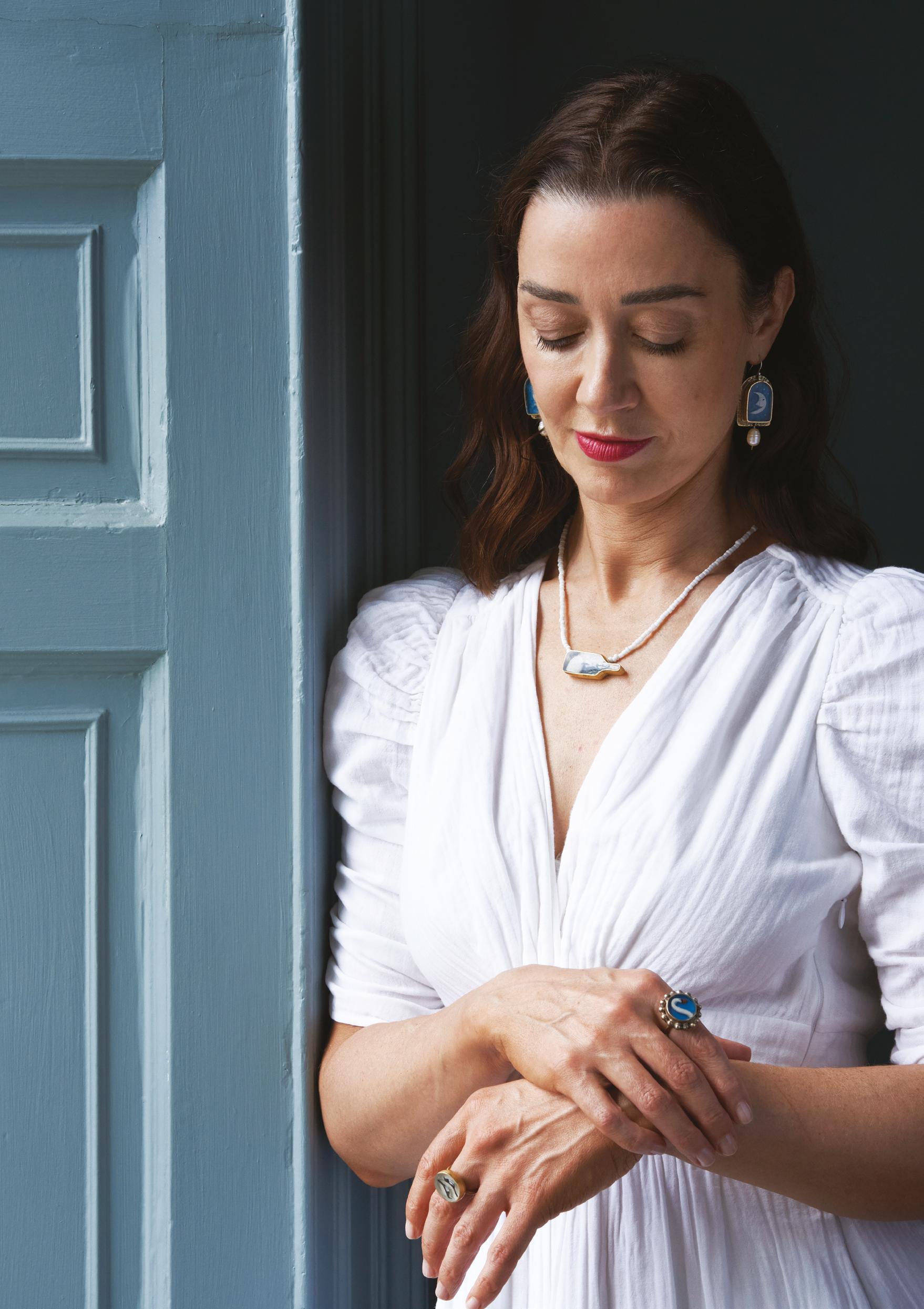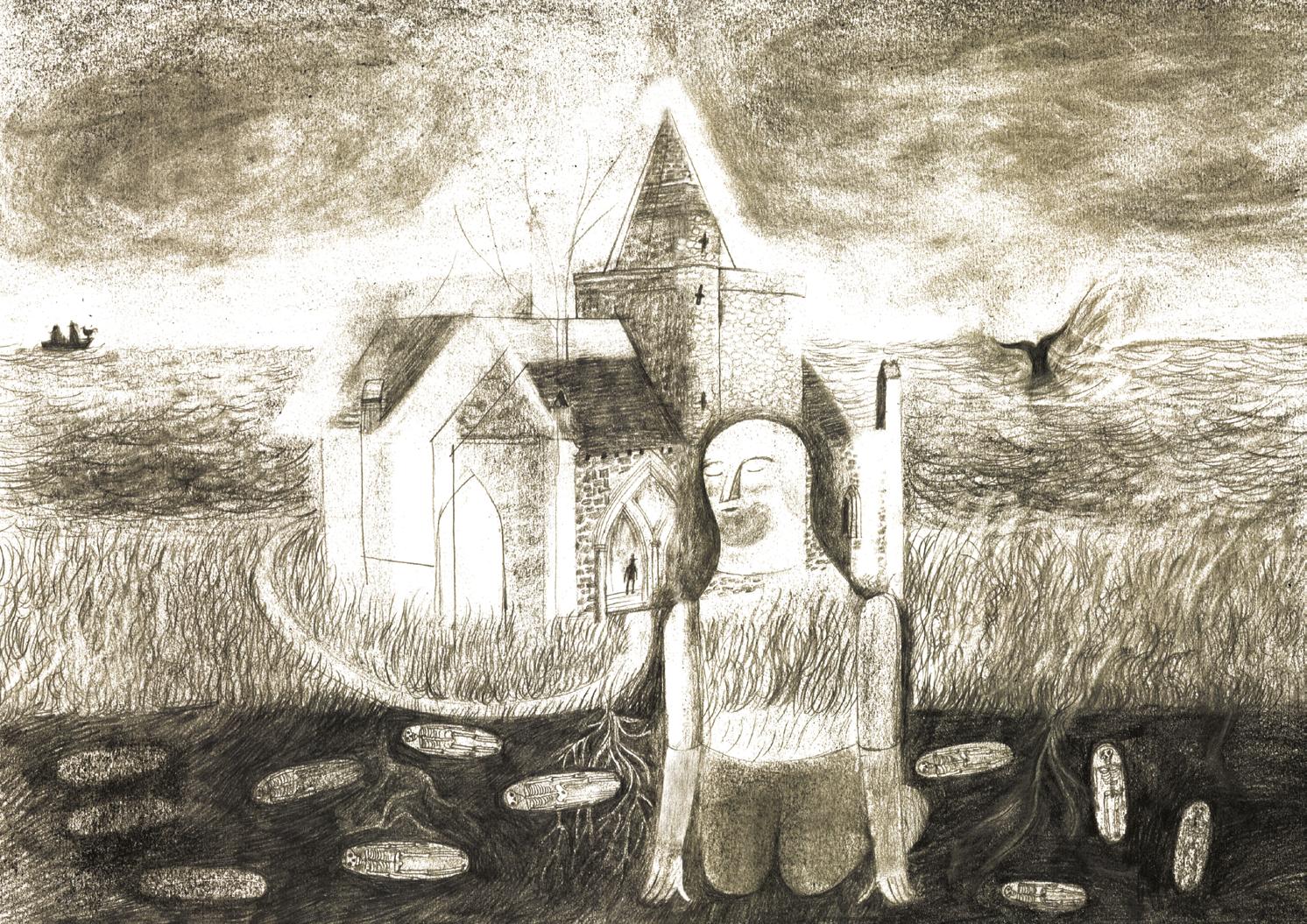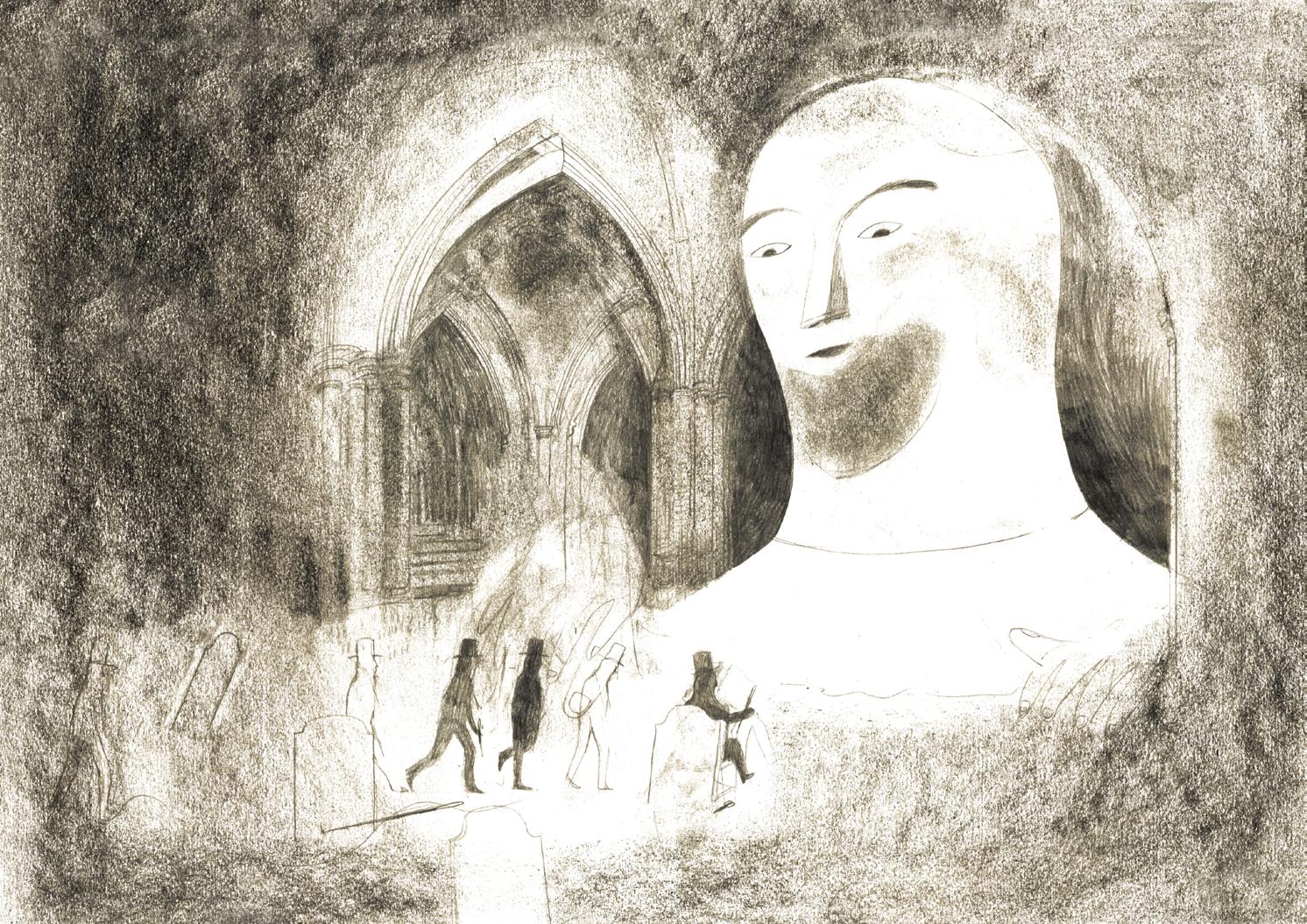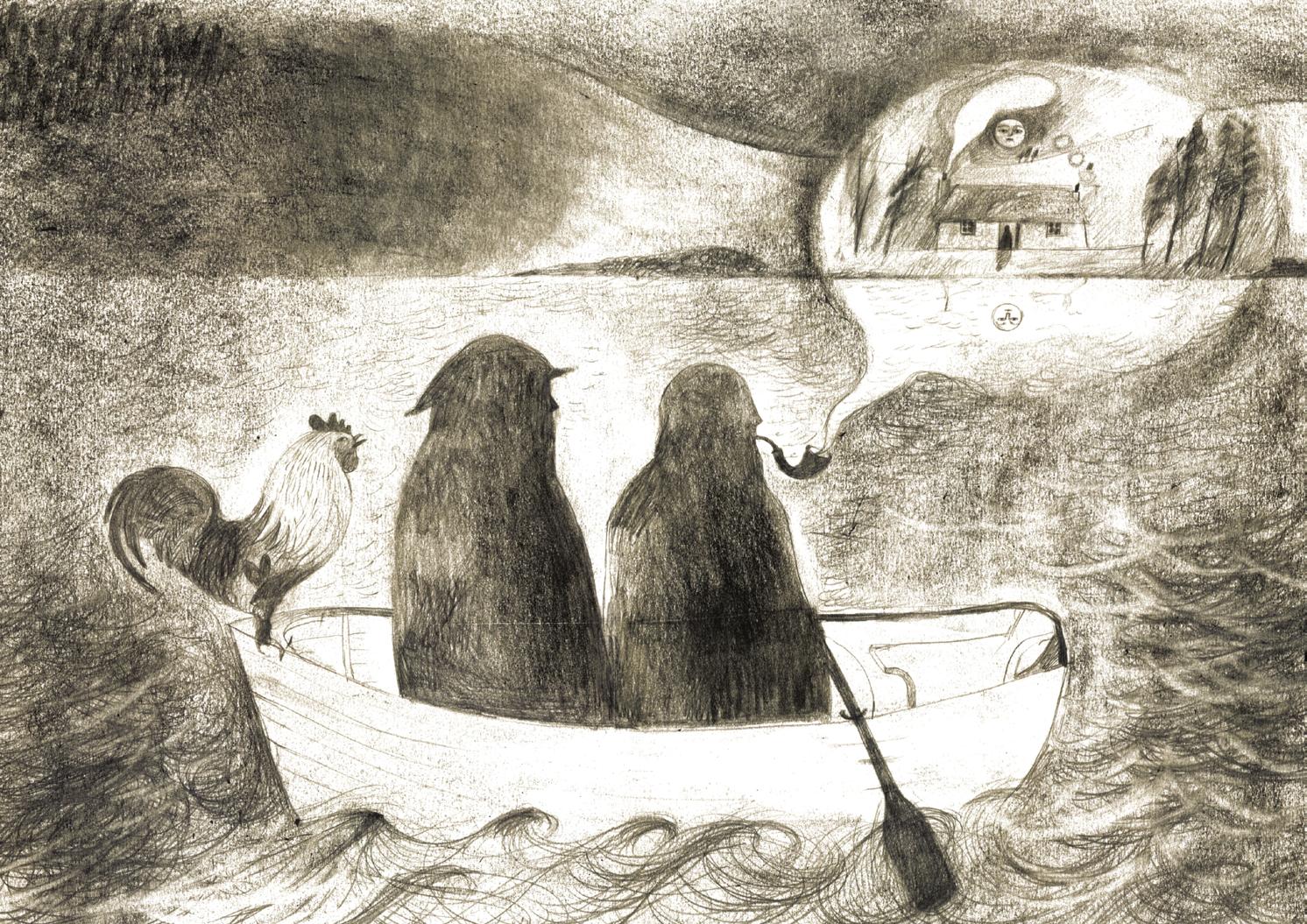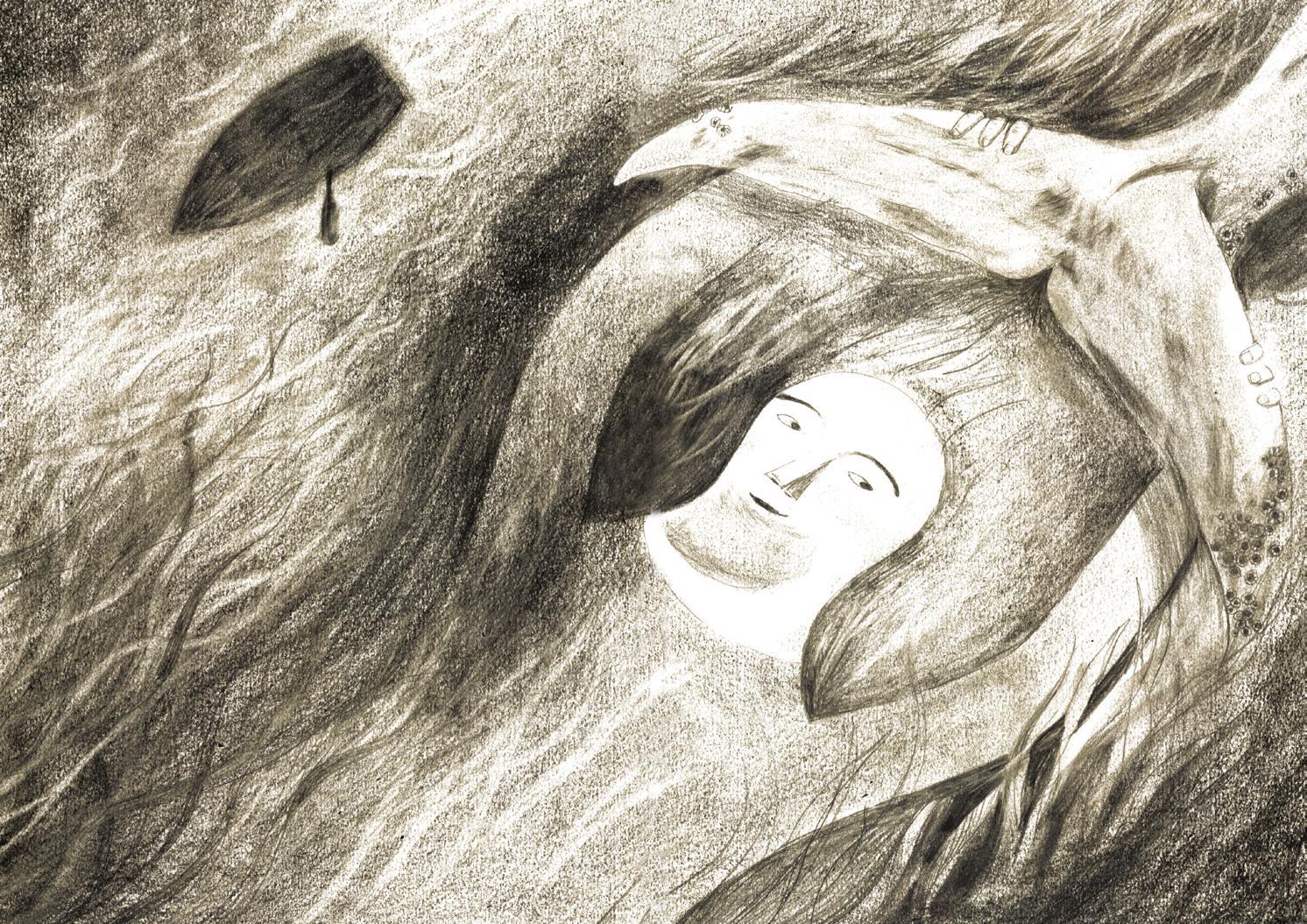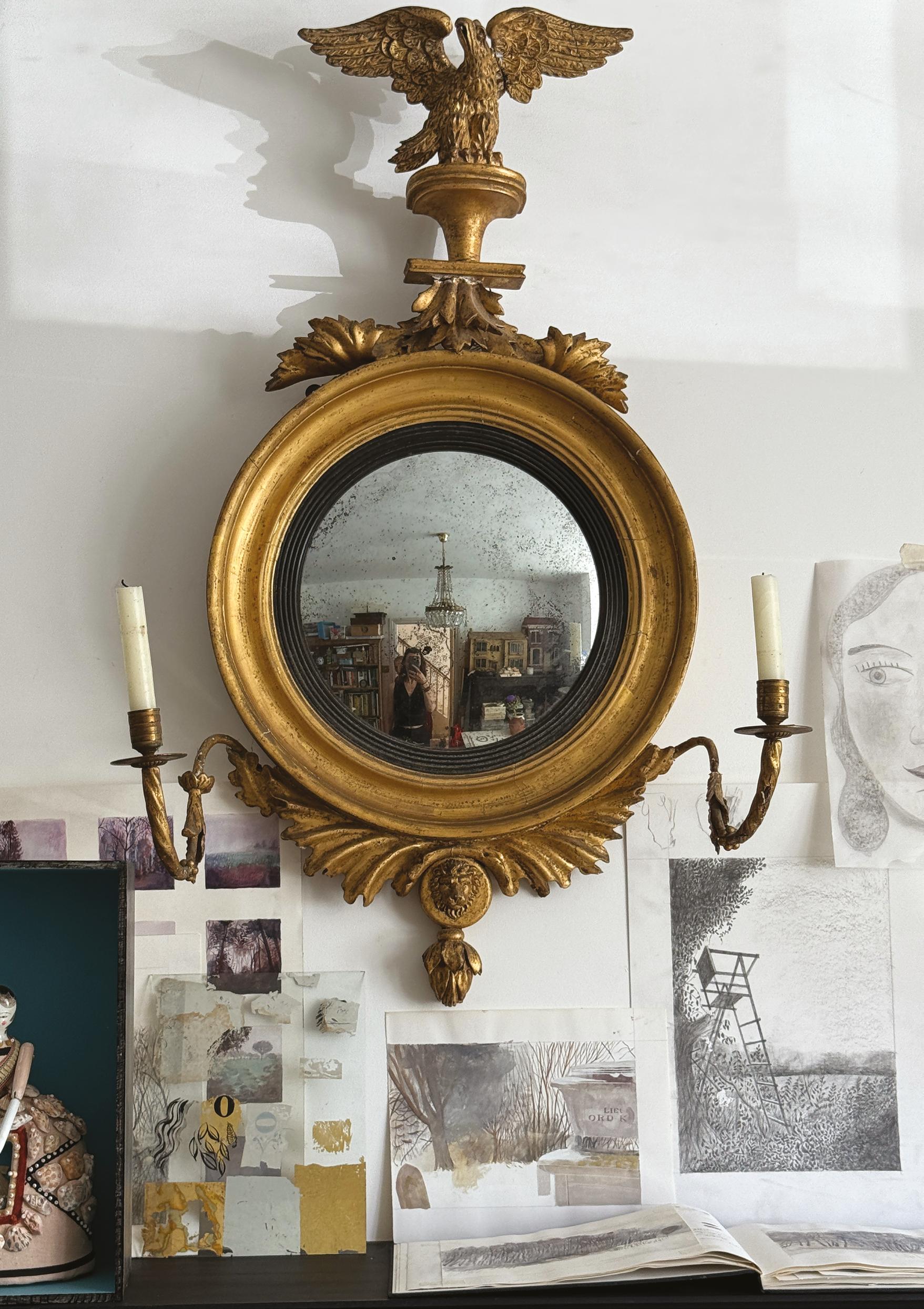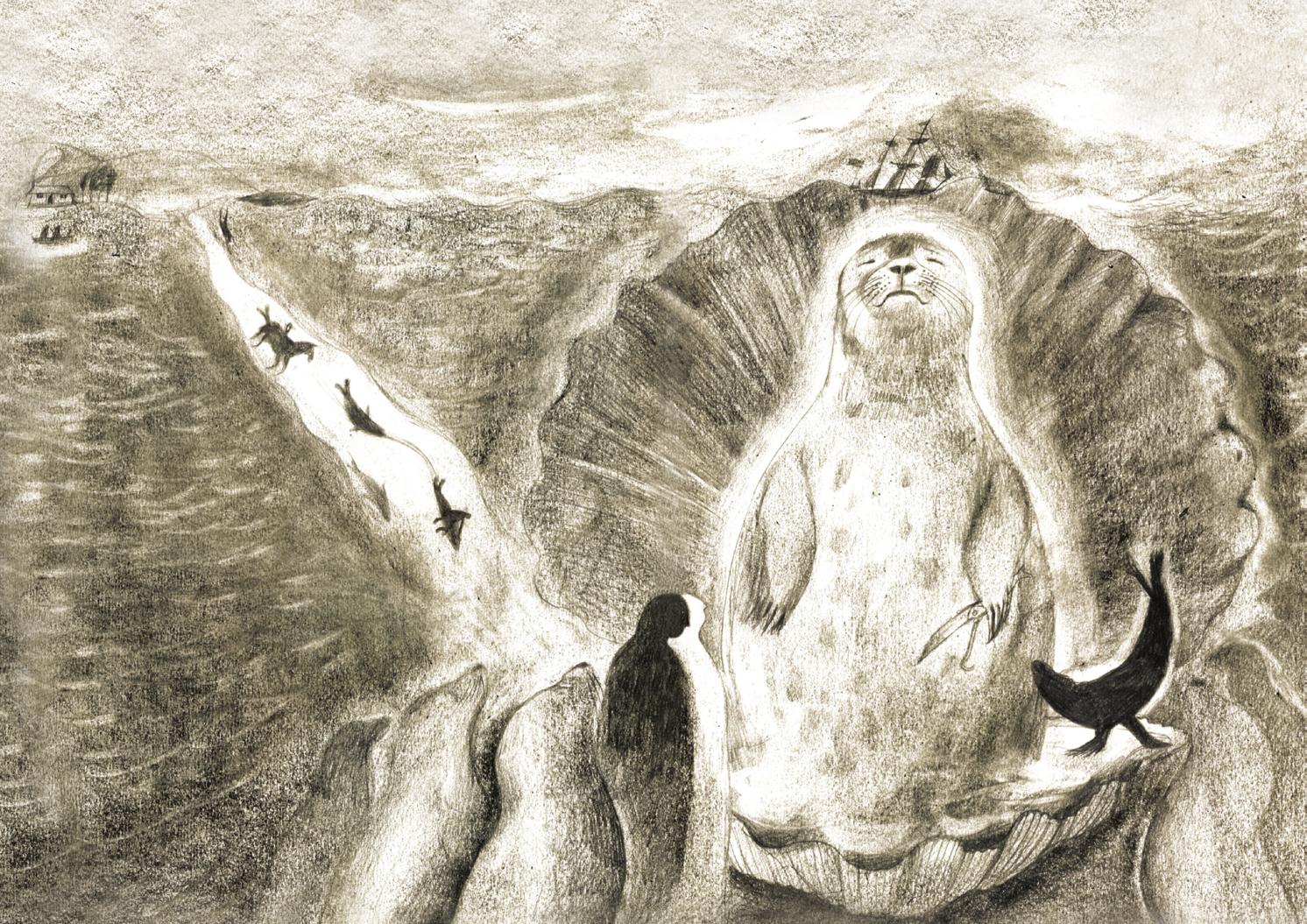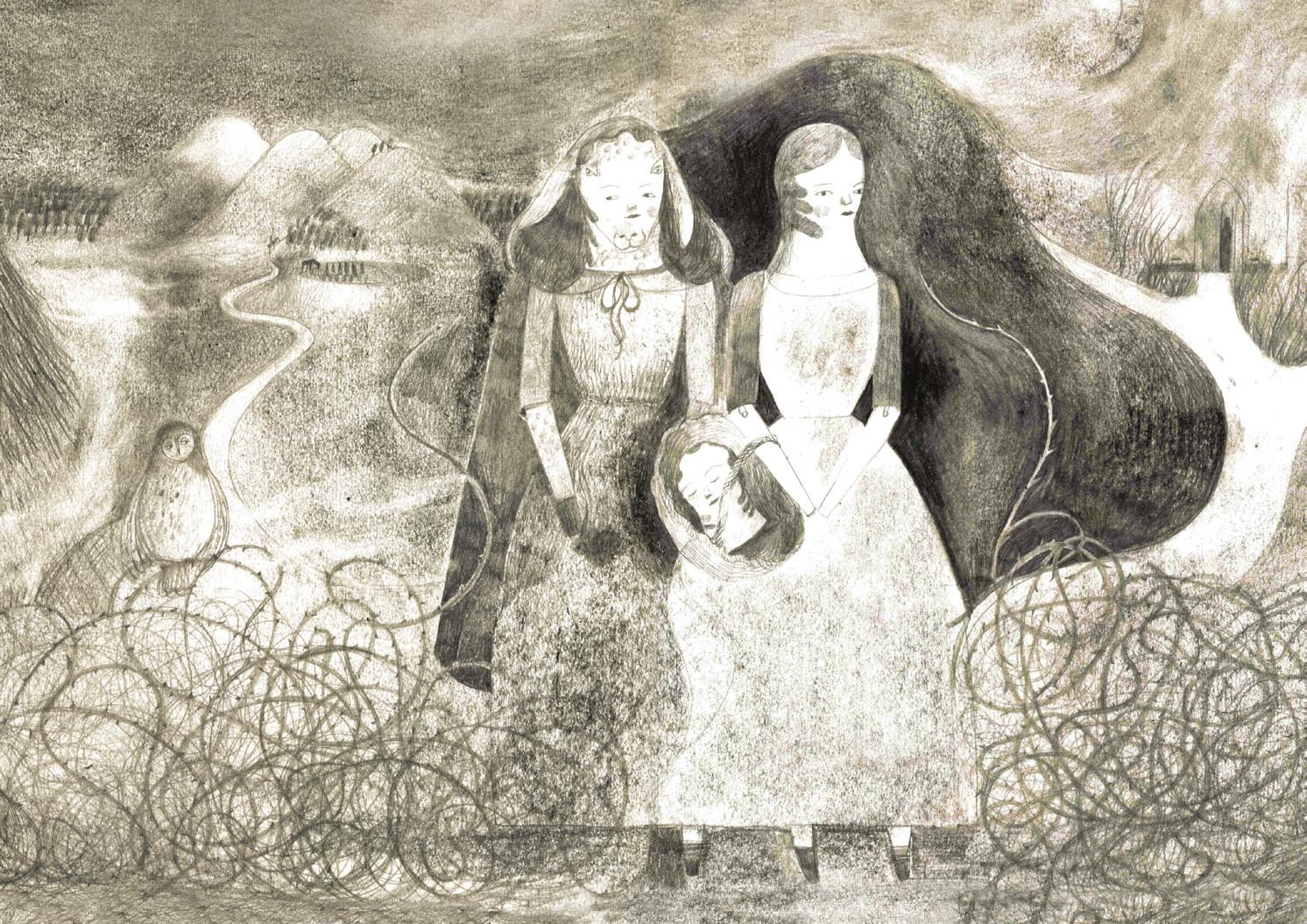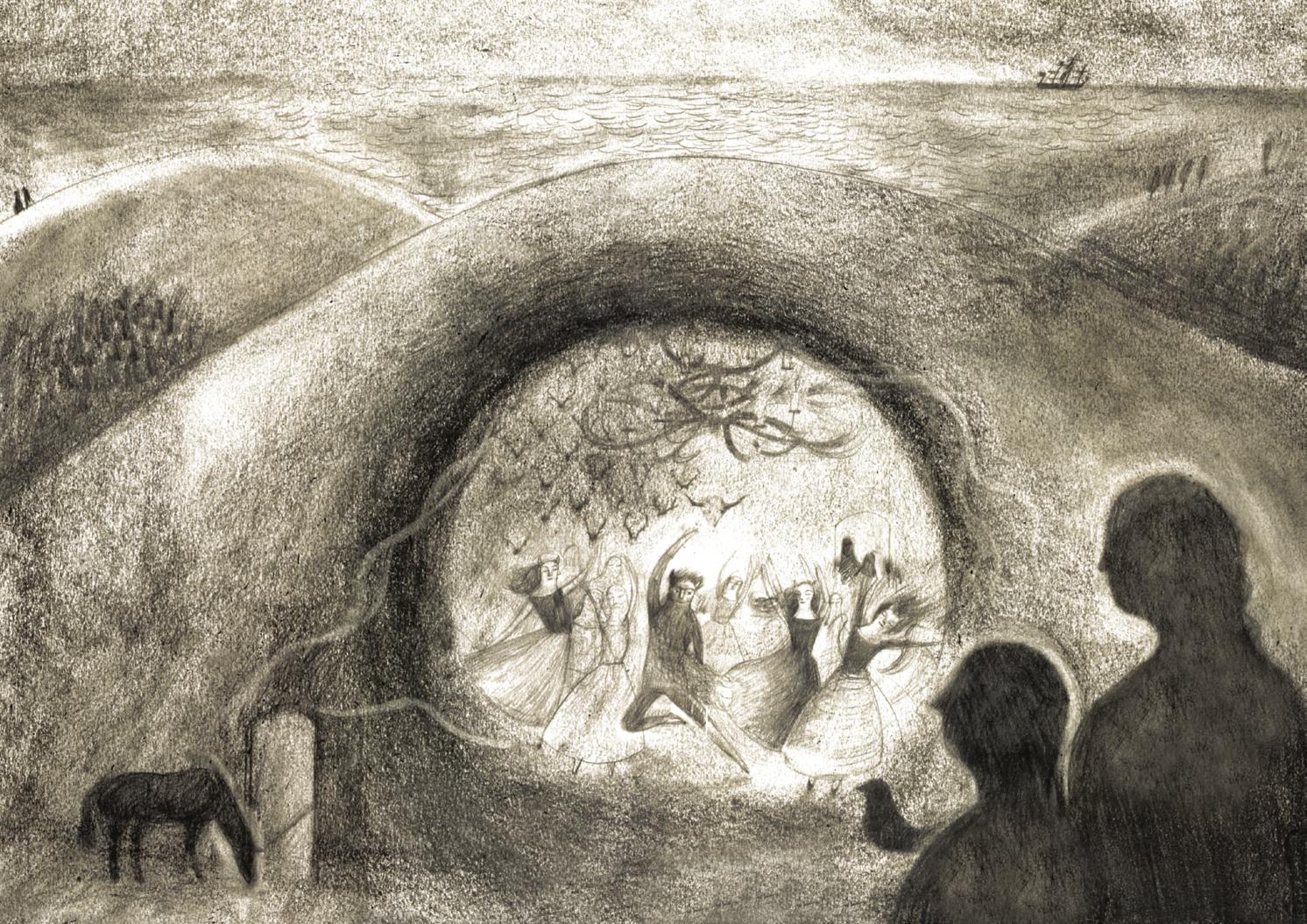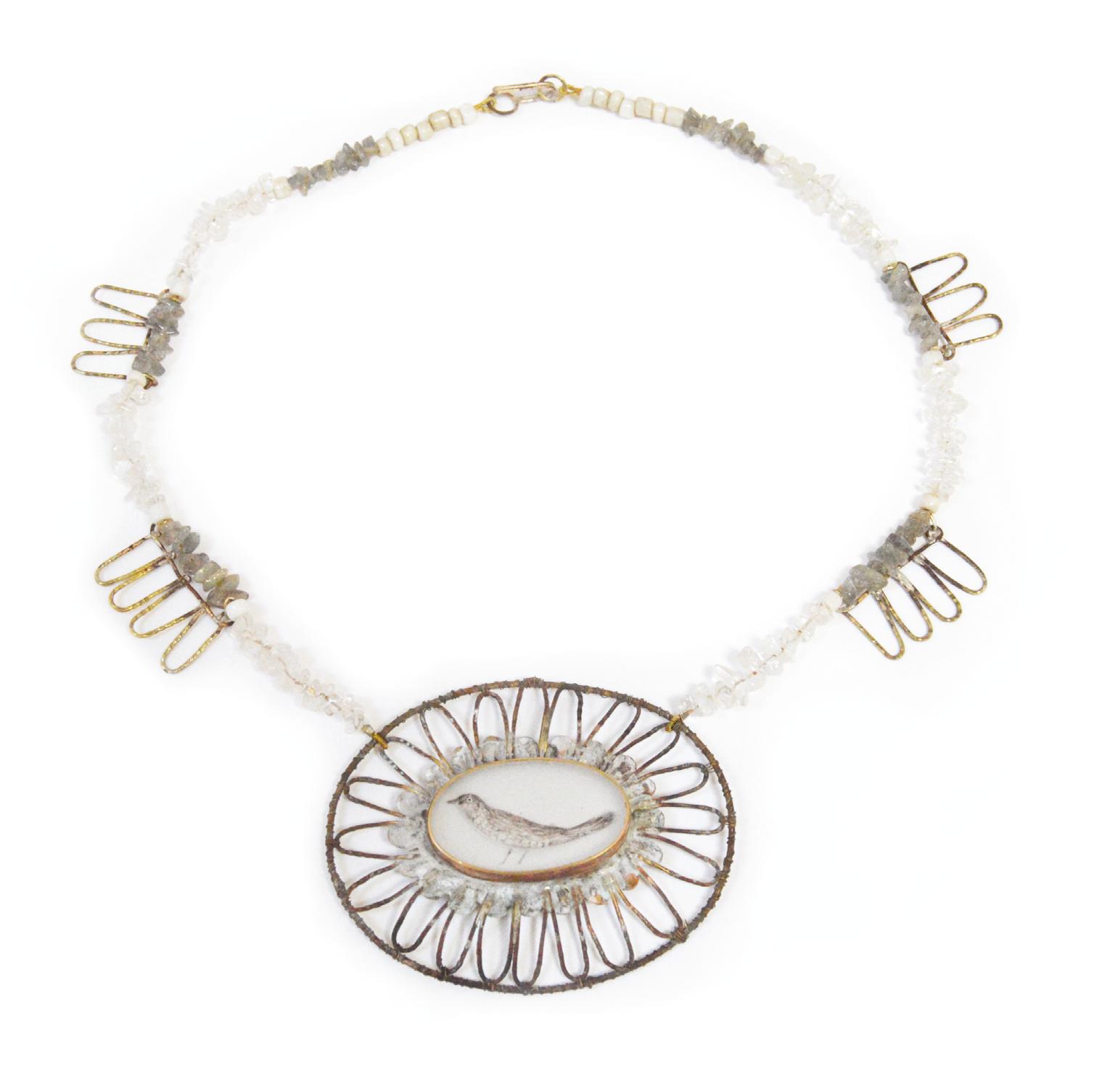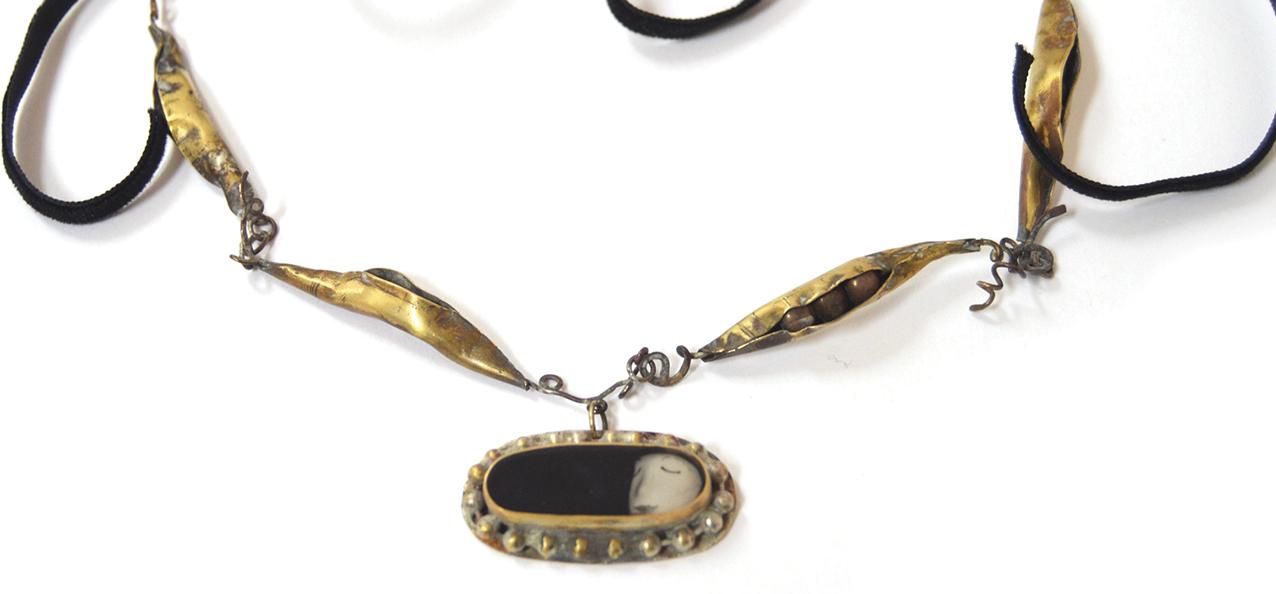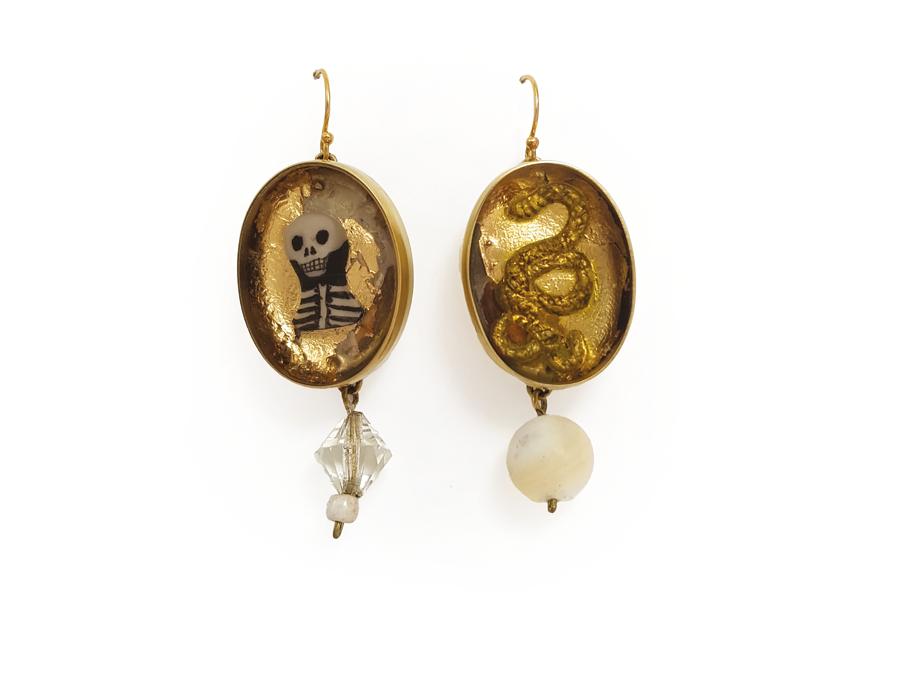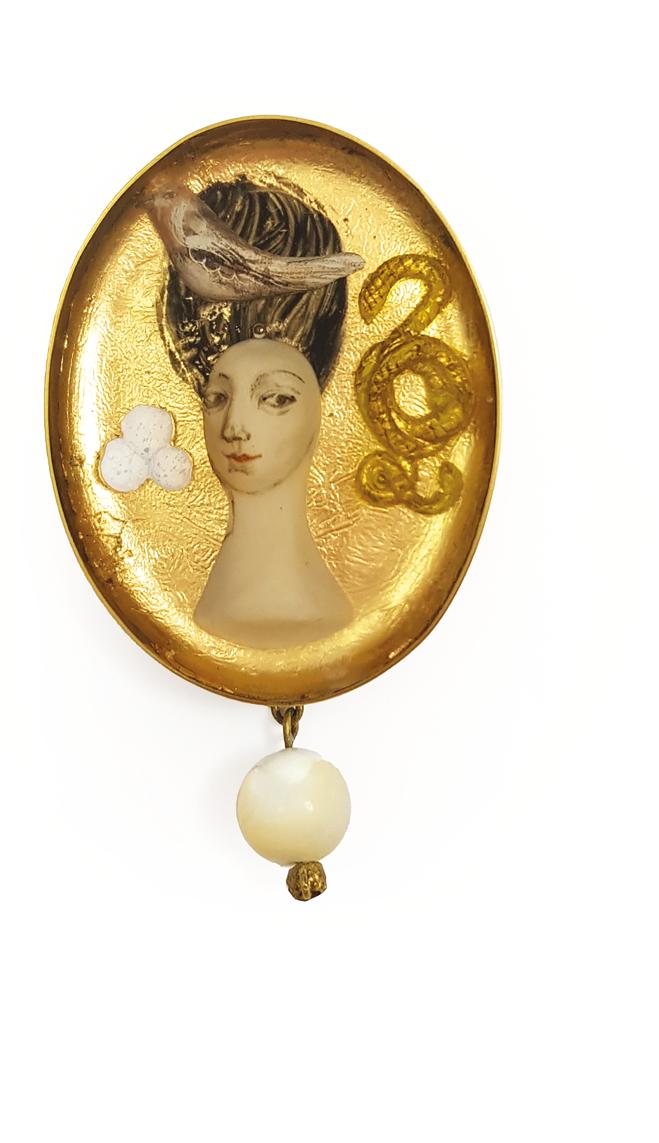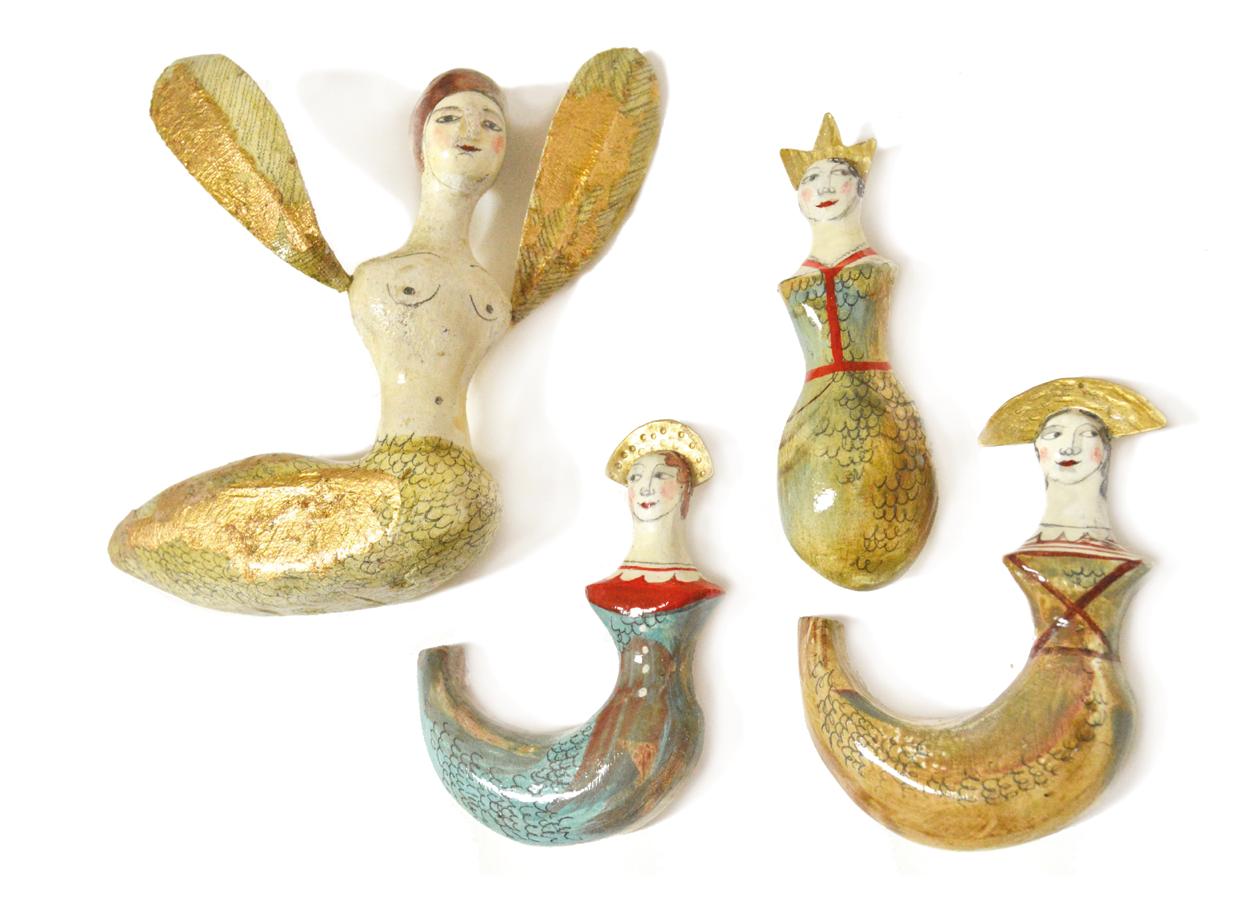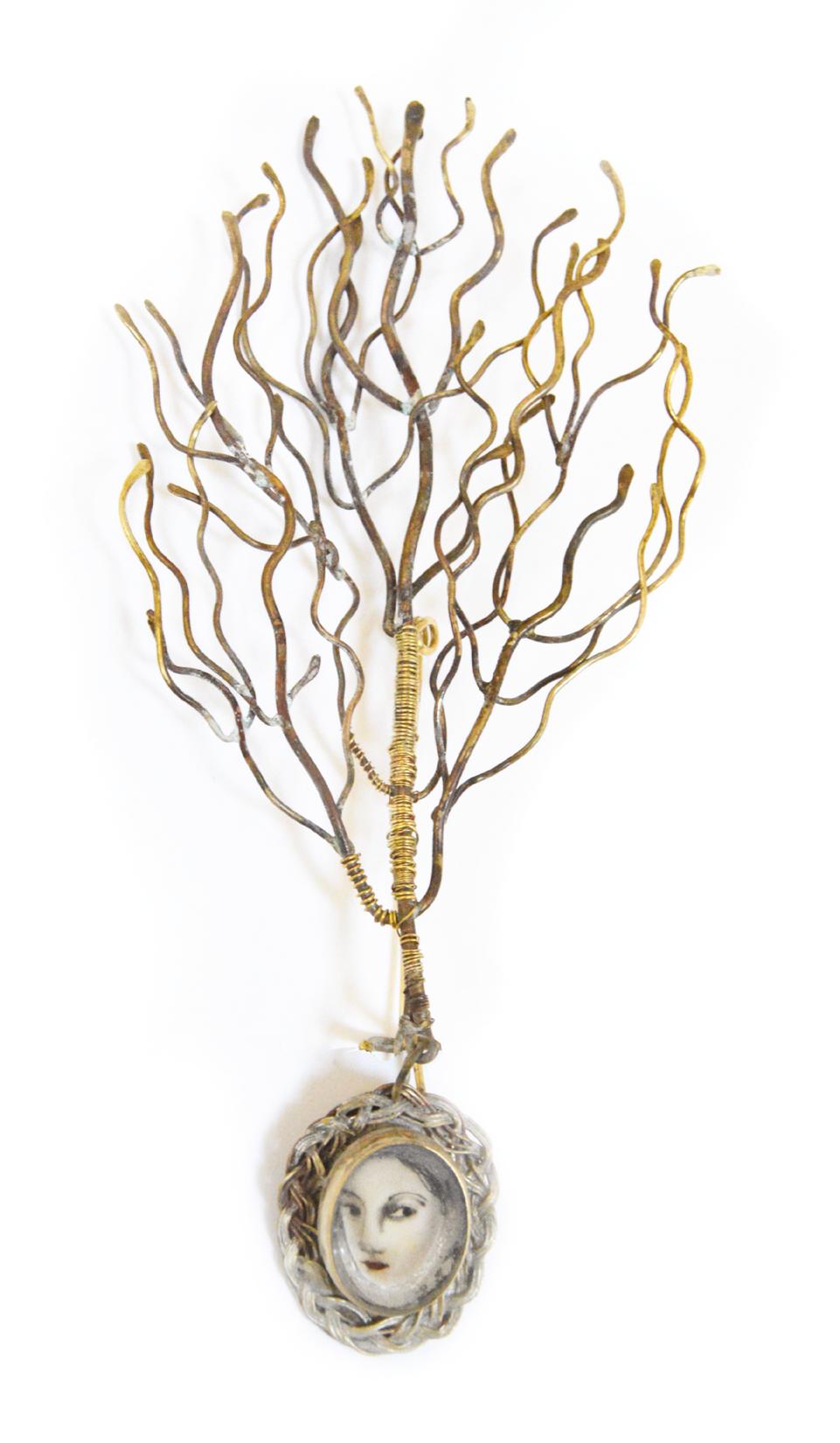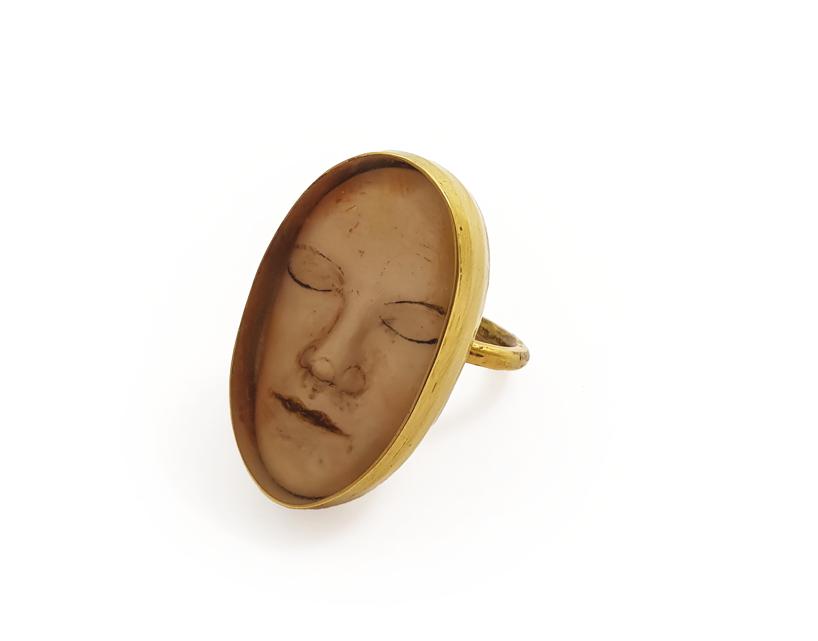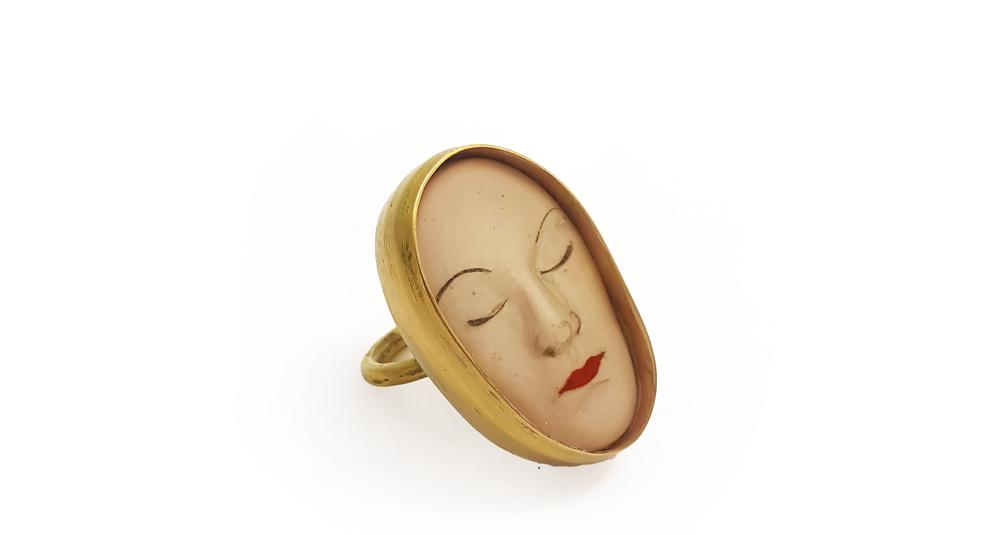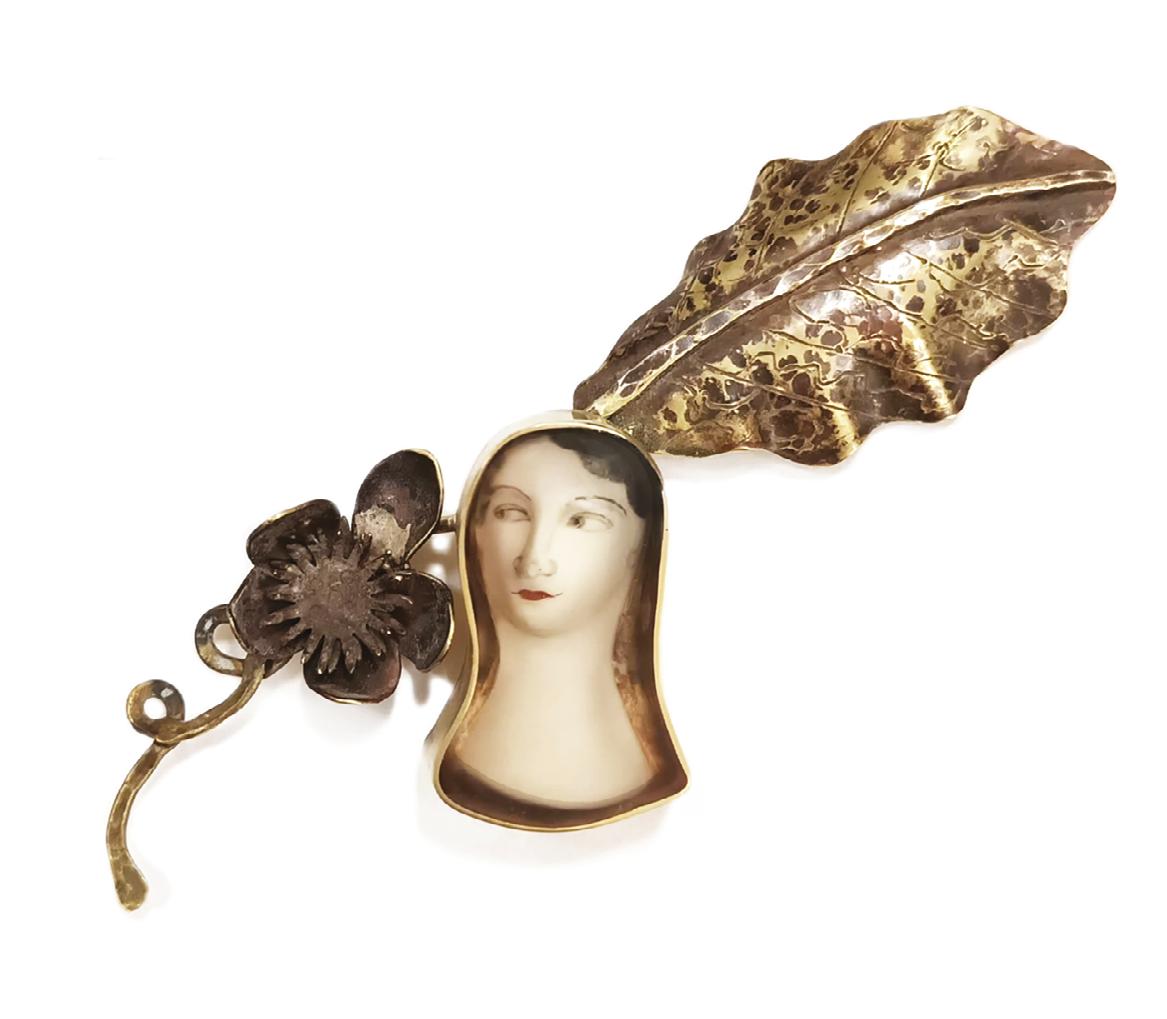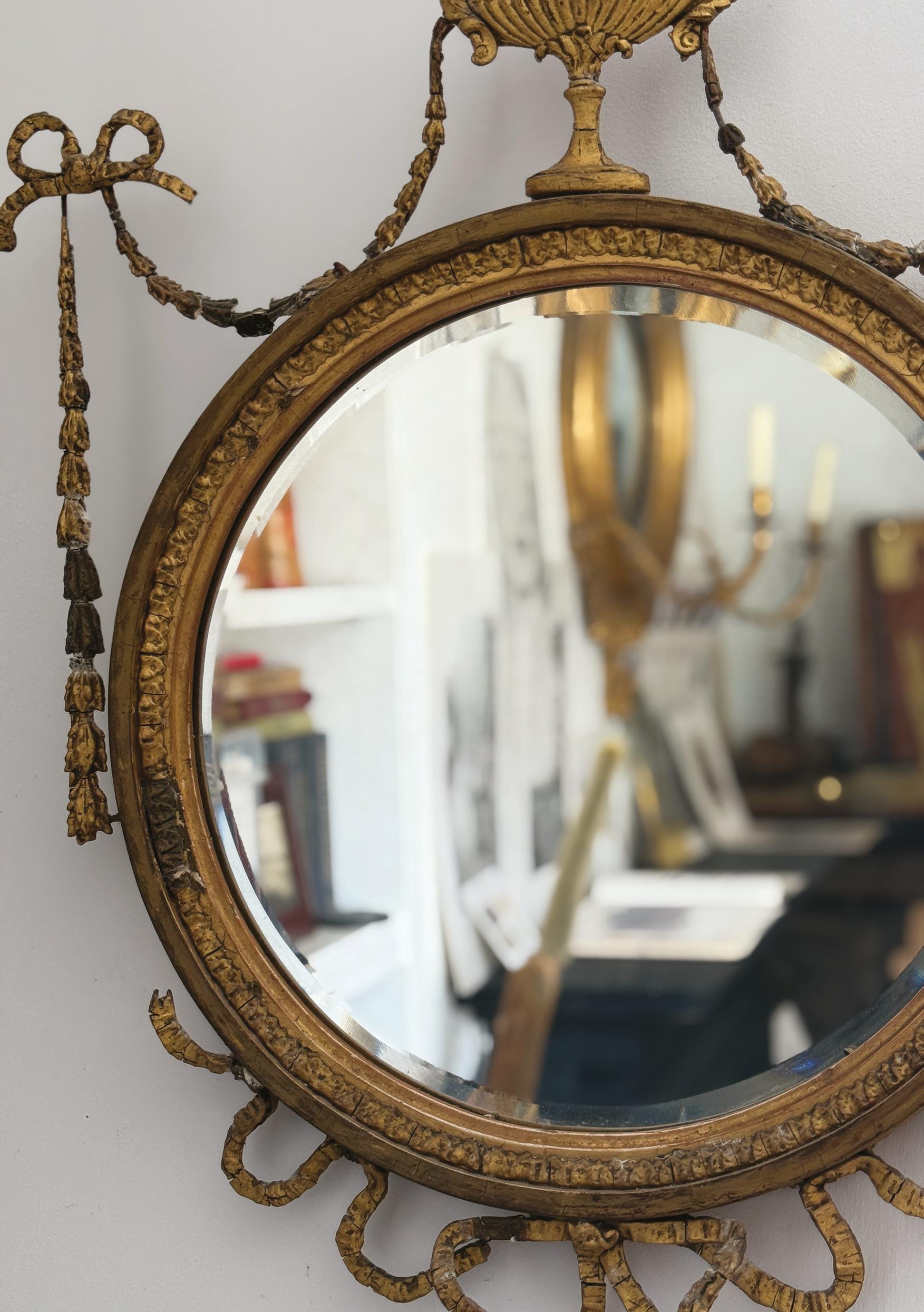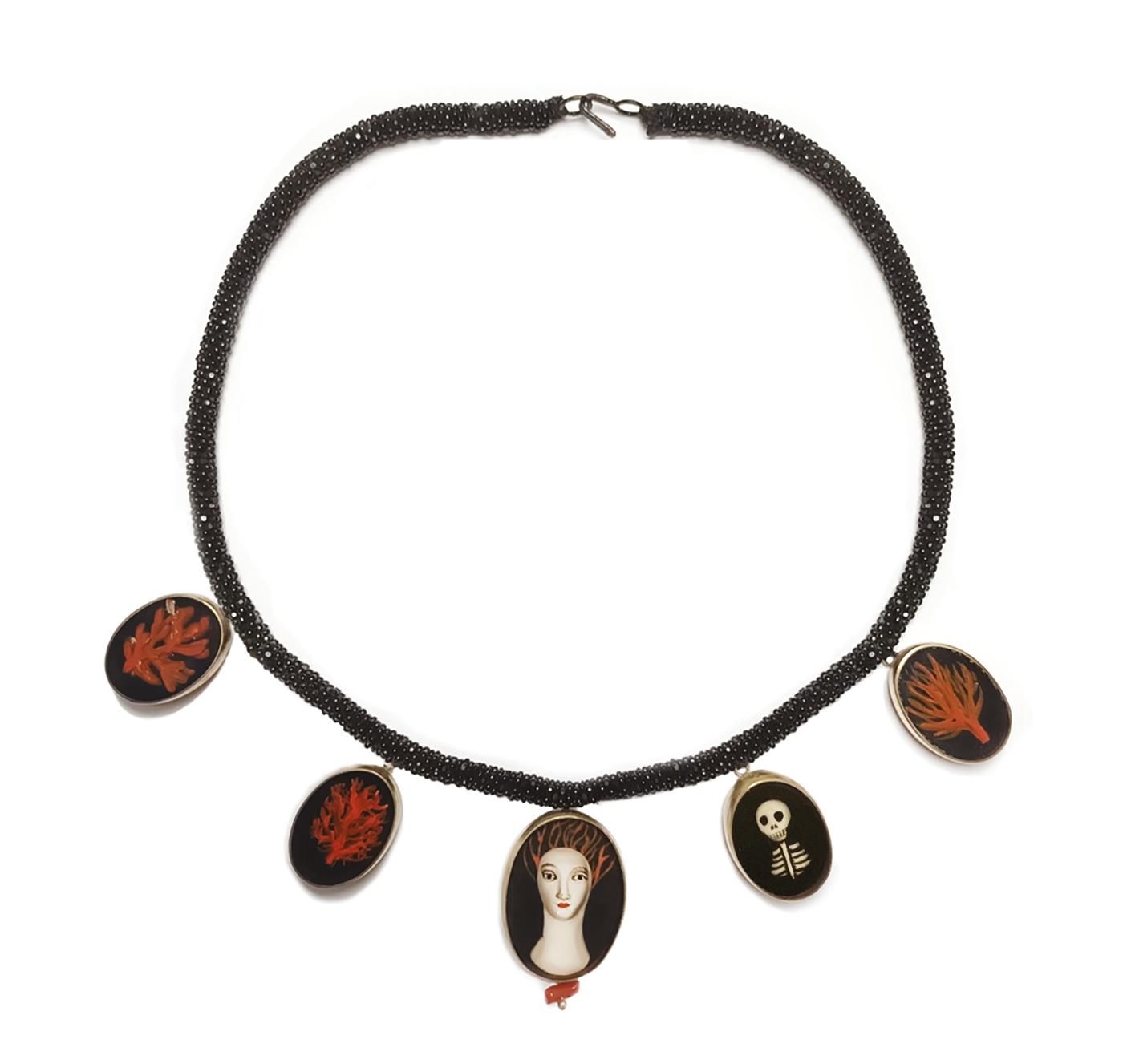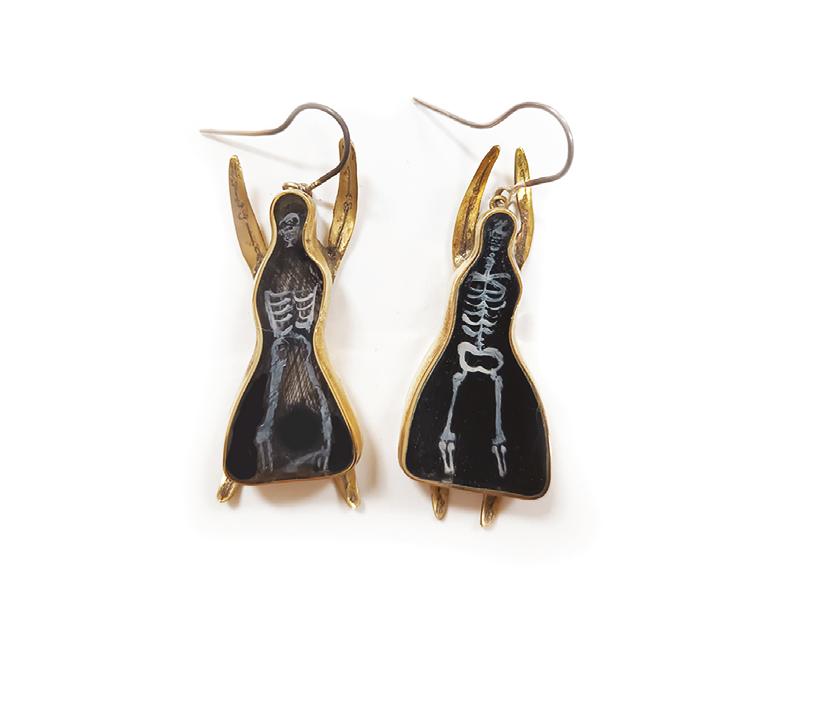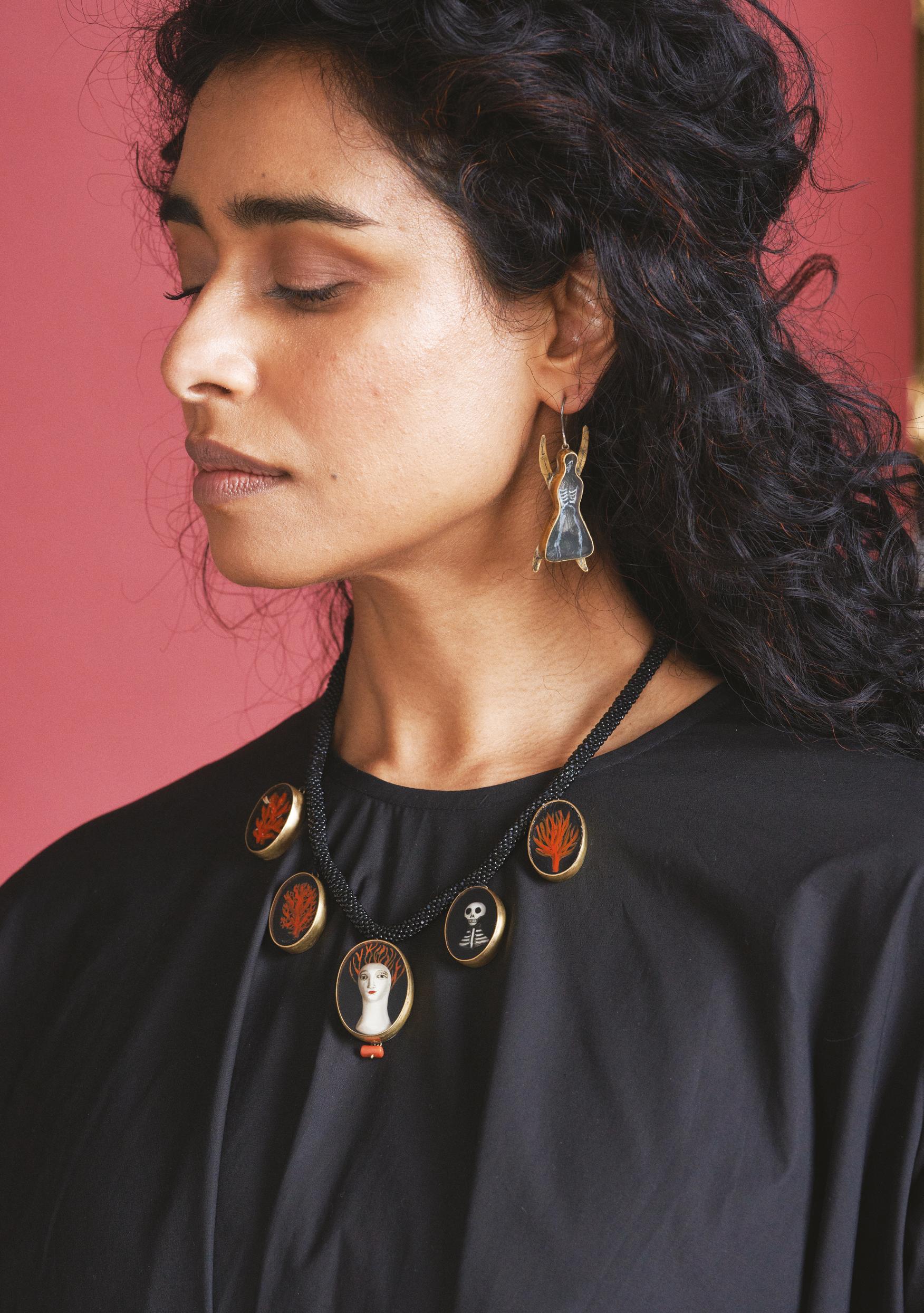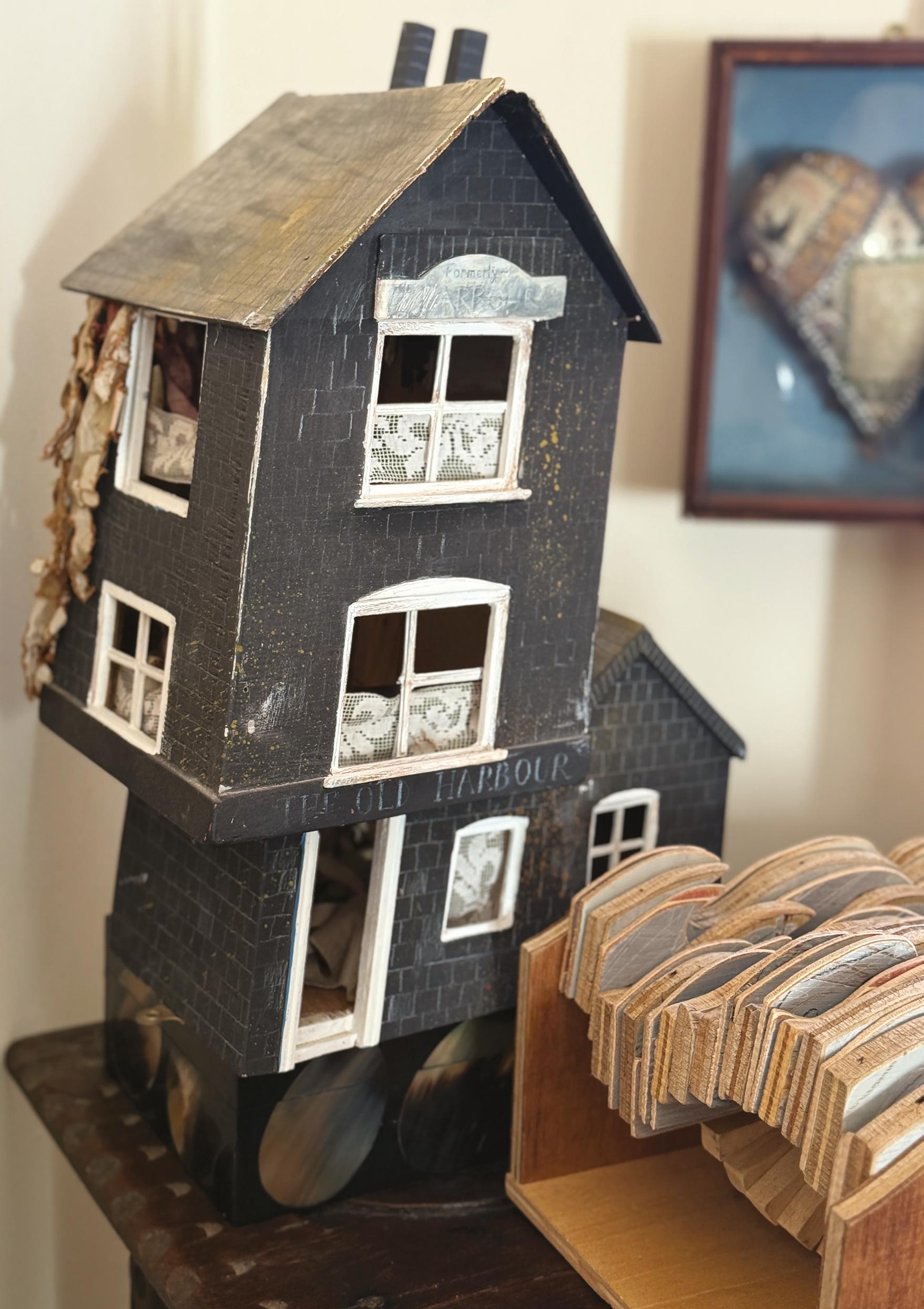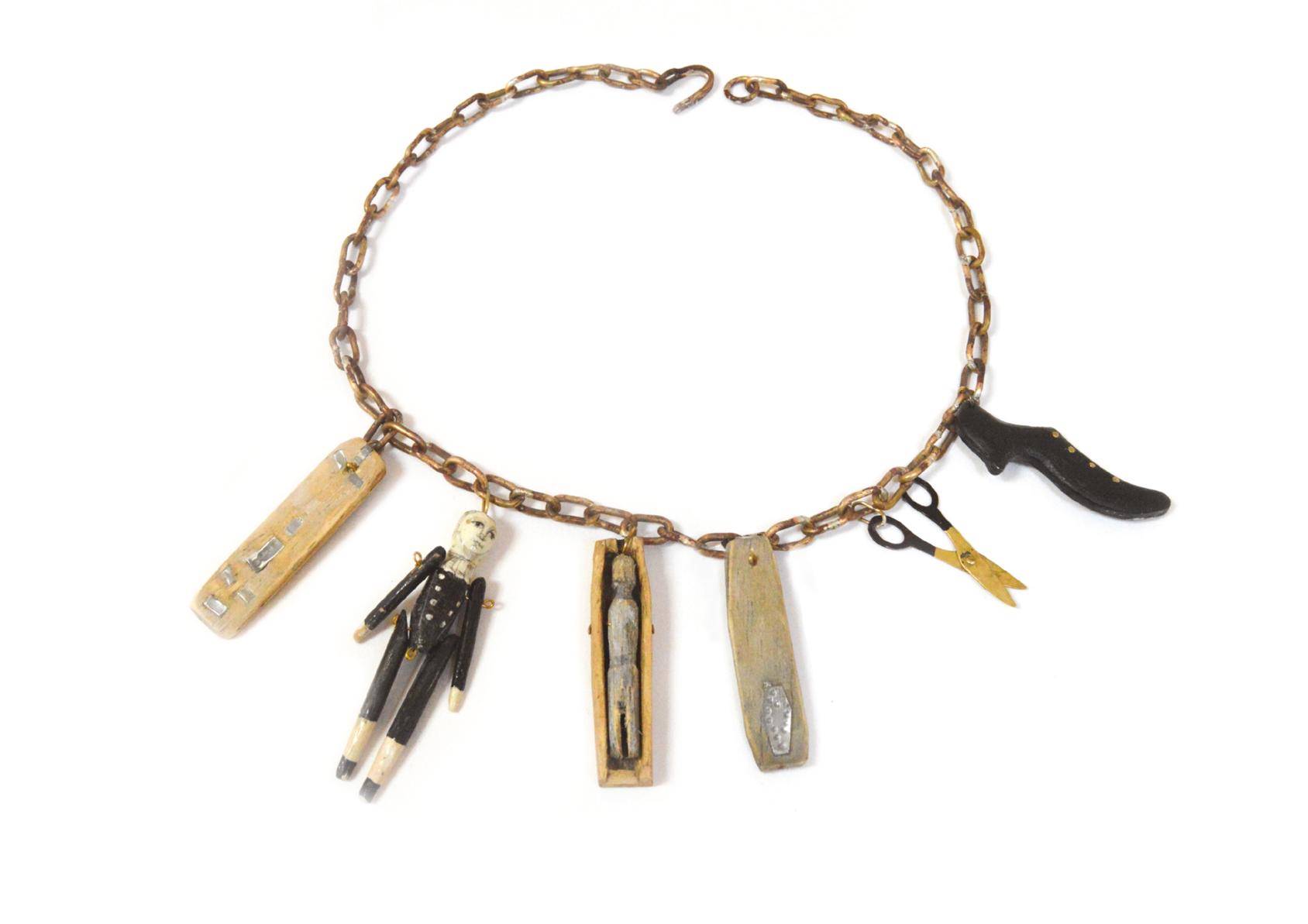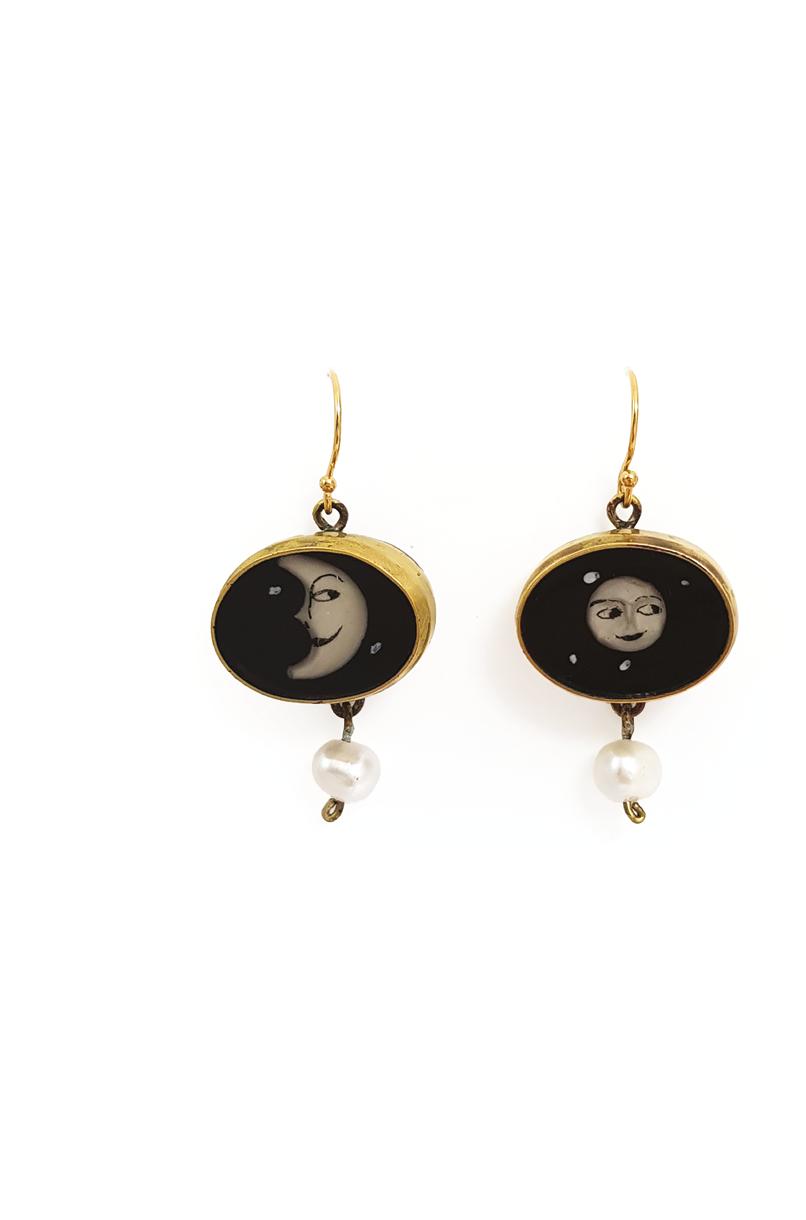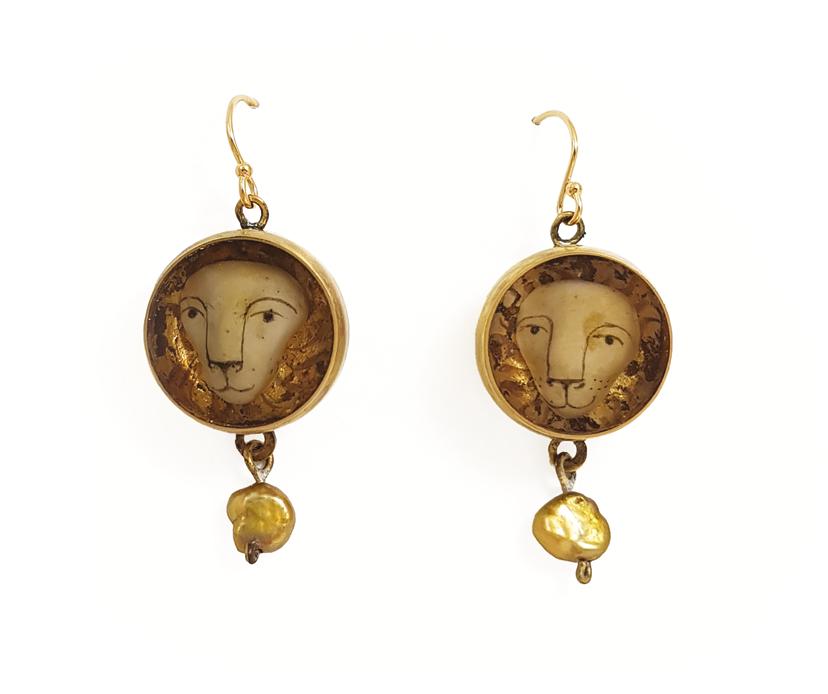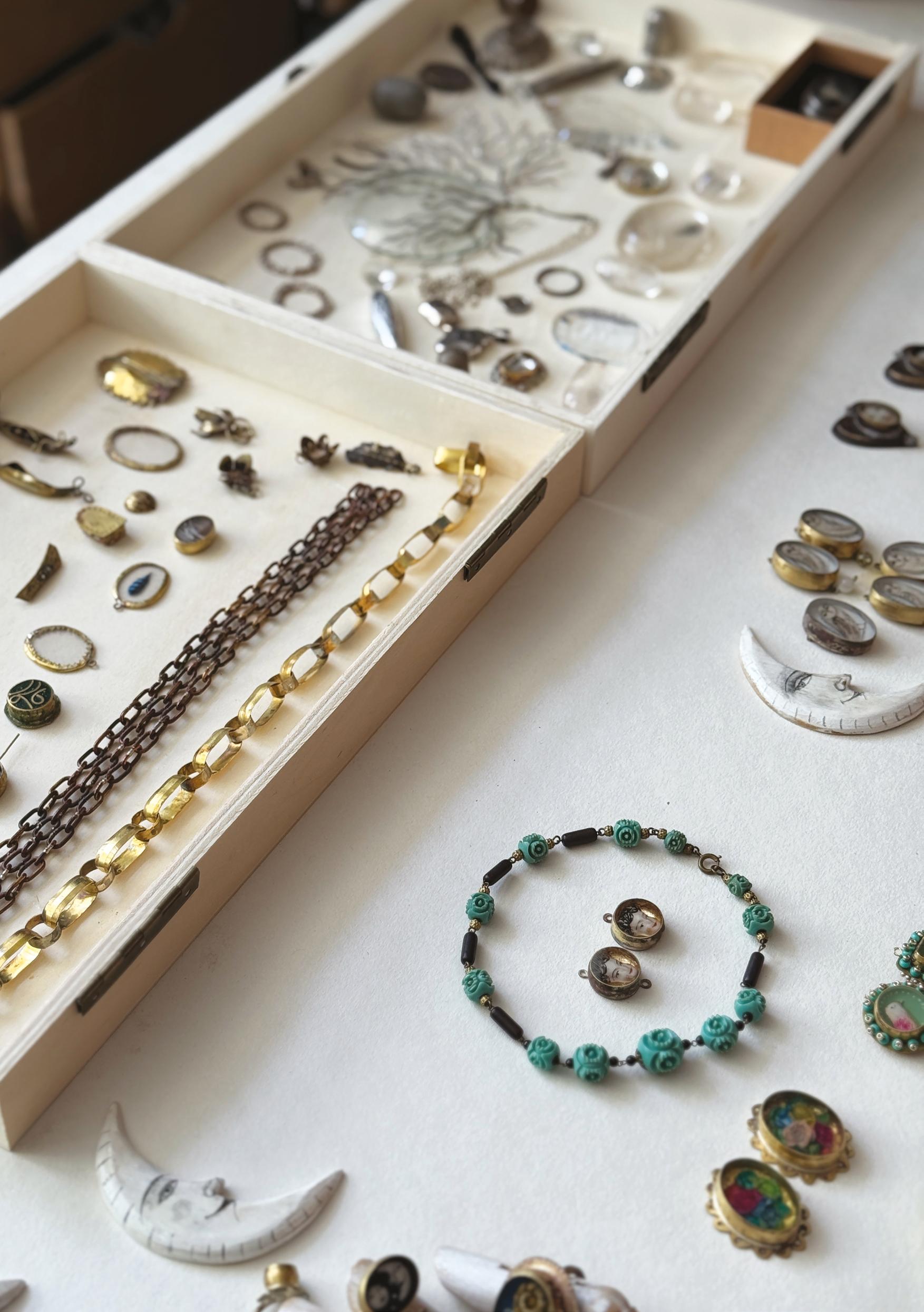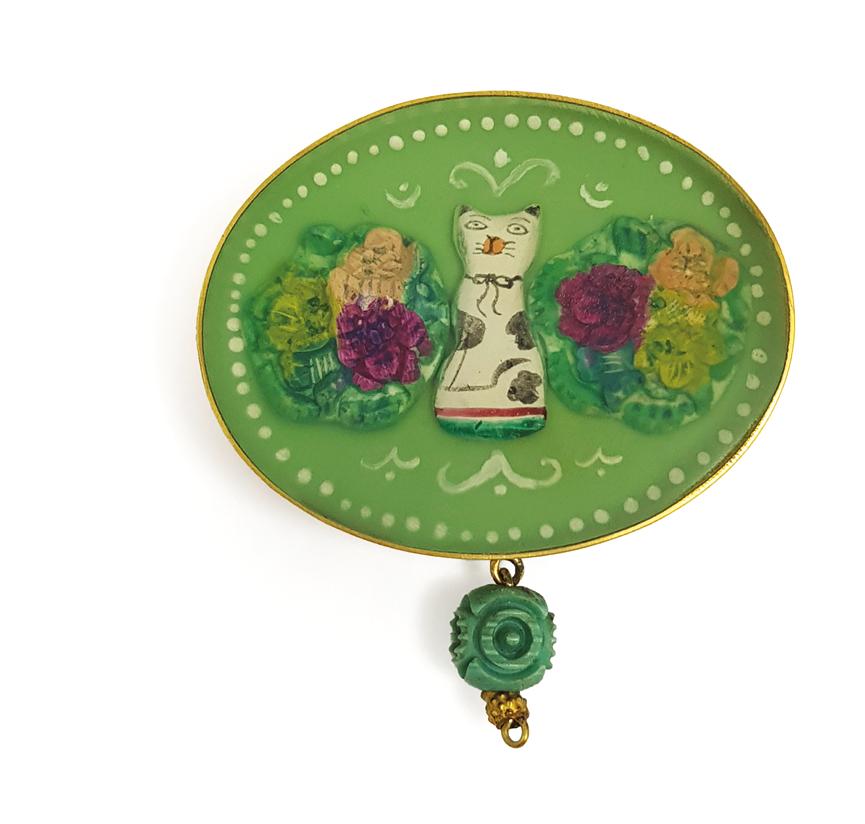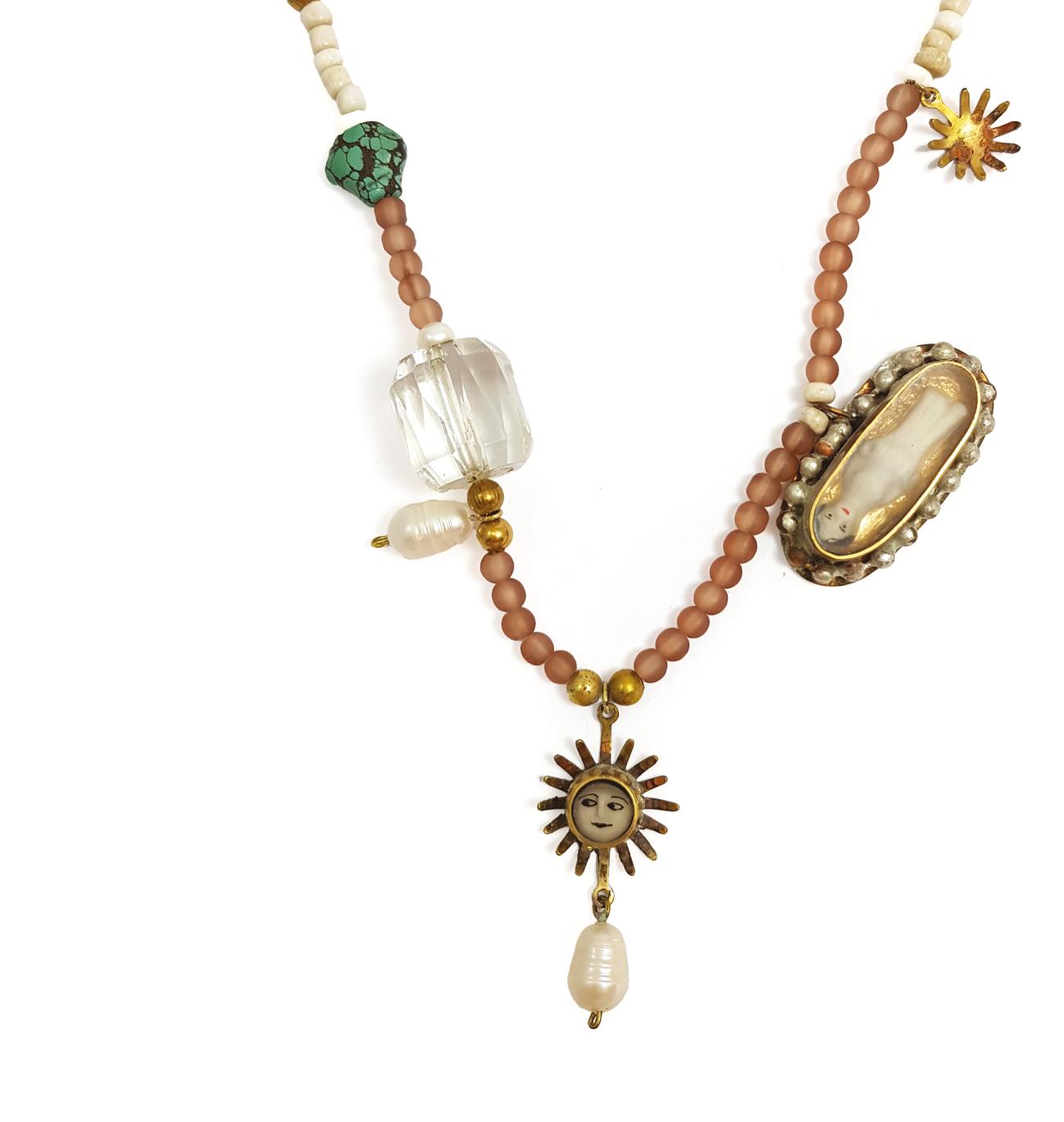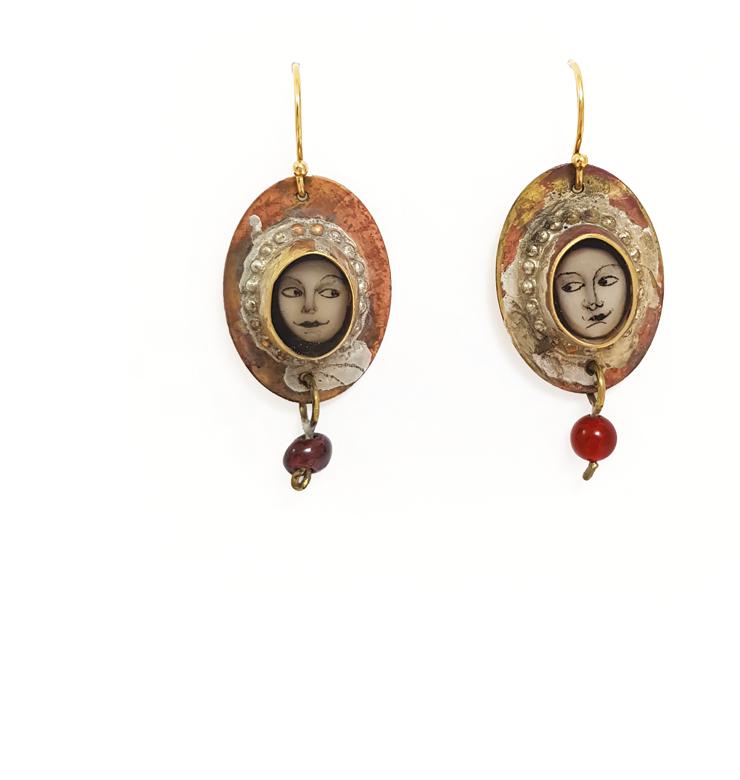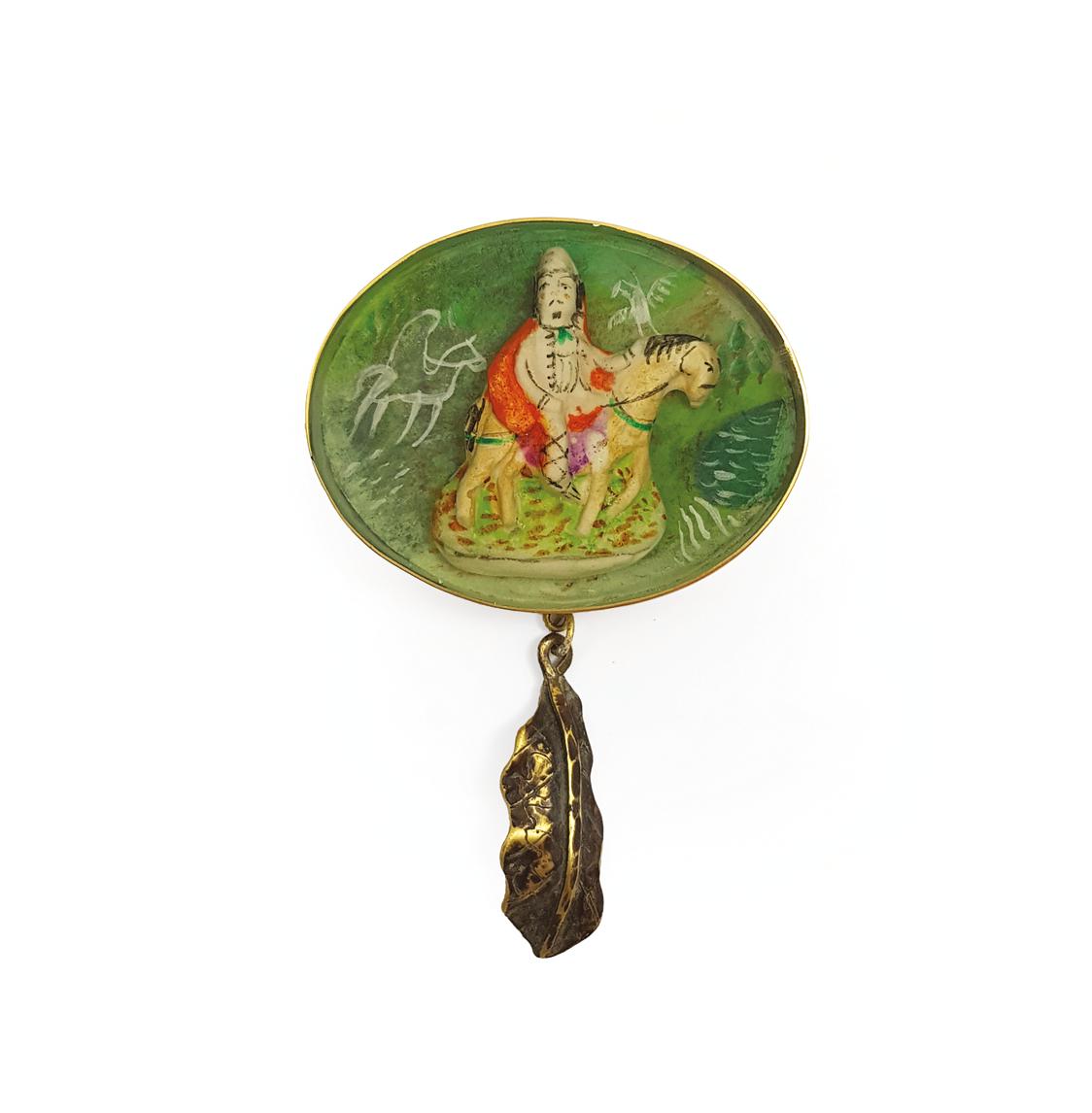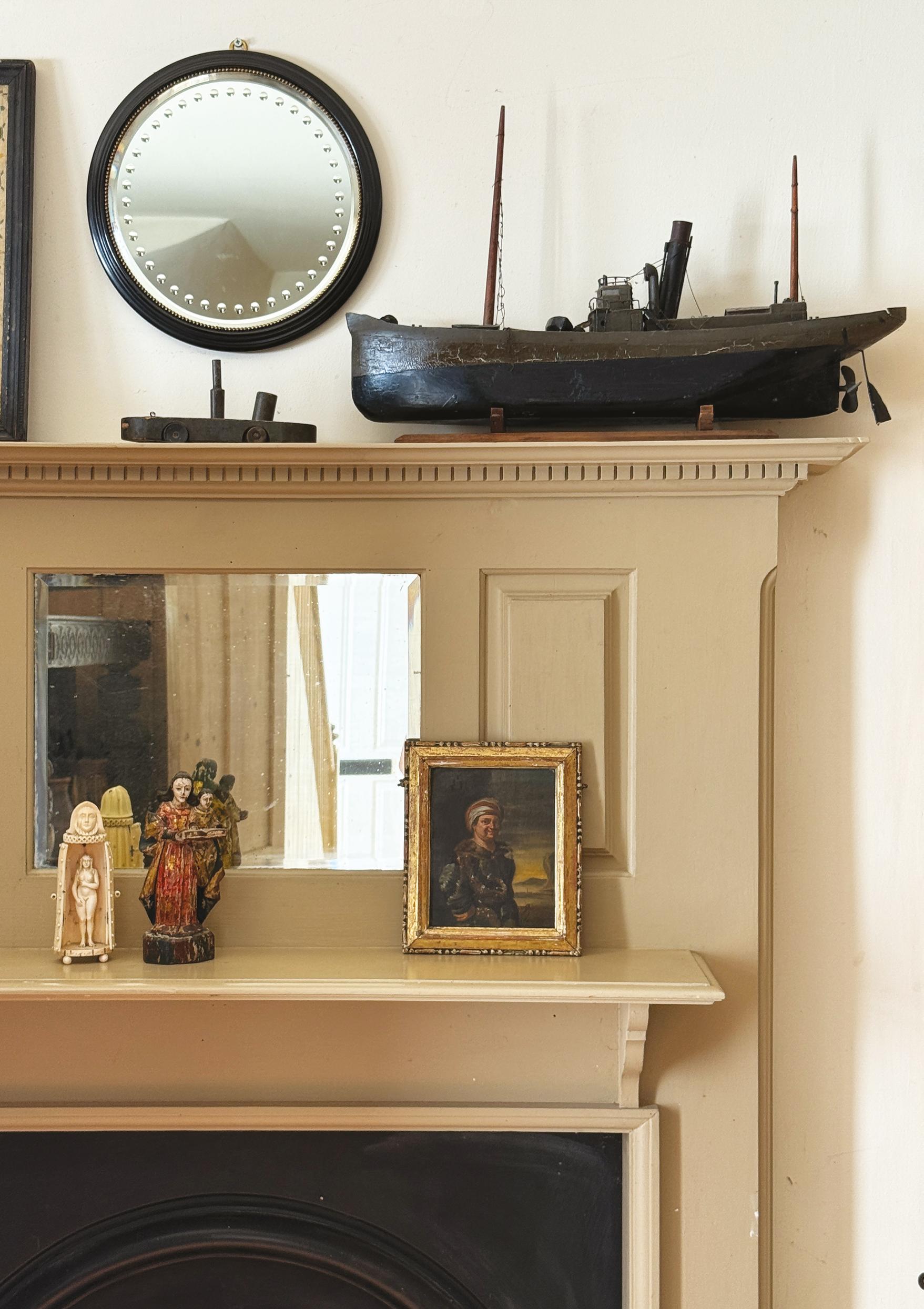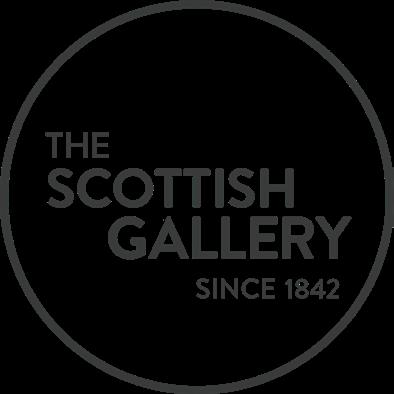Raising Ghosts
For Raising Ghosts I wanted to weave a dreamlike journey through the tales in Scottish Folk and Fairy Tales. Other texts, including Scottish Charms and Amulets and Folklore, Myths and Legends of Britain, fed my imagination. The exhibition brief was Room of Dreams, so I sought stories of sleep and enchantment. Andrew Lang’s Book of Dreams and Ghosts describe ghosts as waking dreams, one of which appears again in the folk tales. Protective charms and amulets in the National Museum of Scotland, rock crystals to protect livestock, hag stones against nightmares, further informed the work.
Folklore often provides quaint logic to control the uncontrollable. Charms protect, fairytales let us project ourselves into tests and choices. For Folk at Heart at The Scottish Gallery I made neckpieces inspired by the tiny mystery coffins in Edinburgh. One belief held that they were made by families of drowned sailors, a way to bury them on land. Combined with my collection of ships in bottles and sailors’ valentines, these inspired further explorations of charms and absence.
Drawing is an important part of this exhibition. It allows me to sift through what resonates with little more than
pencil and paper. One of my drawings relates to The Sprightly Tailor, in which a tailor dares to sew trews in a haunted church. As a giant head rises from the floor and demands acknowledgement, the tailor keeps sewing, chanting “I see that, but I will sew this”.
In my drawing the head is benign, reflecting my interest in appearances that deceive. The same head reappears in The Lonely Giant, riding on a whale’s tail. The tailor’s determination resonates with me. In my twenties I worked as a costumier for a Scottish touring opera, sewing frantically while rehearsals raged around me.
Another drawing recalls The Seal Catcher and the Merman, where a man is dragged to the sea’s bottom and judged by a seal jury. Across many tales, incantations and retribution recur, shaping the pieces I have made.
I grew up before the internet, with restricted television and long days of reading, climbing, cycling and drawing. Boredom was met with a push toward practical activity and our grandmother endured jars of rose water perfume my sister and I made. At fourteen I was captivated when I first encountered Hockney’s Grimm etchings.
Being an artist has always felt like compulsion rather than choice. My family are makers in different ways, and creativity was encouraged. Even now I hesitate to call myself established, but being an artist is part of my identity. I get restless if I am away from my bench for too long. I studied Textile Art and worked for a decade at Artsway making automata and dolls, then returned to study Sequential Design and Illustration at Brighton. That course confirmed my desire to combine object making with drawing and painting, which led me toward working with resin and brass.
Surrounding myself with handmade artefacts by makers from other centuries seeps into my subconscious. Sometimes I draw these objects, but more often they emerge naturally during the sculpting process, in the forms I encapsulate in resin or in the colours I choose for painting. Our house was once
an alehouse, and we spent years restoring it. At that time, I made automata about a local figure obsessed with taphophobia. Looking back, the bare wood, minimal paint and distressed surfaces I used were shaped by living in a building site. During Covid, when we could not leave the house, my collections gave comfort as well as inspiration. My workroom became my sanctuary.
Ships in bottles, taxidermy and votives behind glass are motifs I return to repeatedly. The moment an object becomes untouchable through glass or resin fascinates me, as if the imagination leaps at the act of preservation. I have collected costume and mourning jewellery since my teens. A circular enamel locket with a portrait was my
first encounter with figurative jewellery and it lodged deeply. Another favourite object is a painting of a sailor telling a tale to a strange group, something in it feels uncanny, as if one figure might be dead. A postcard of a Guy Johnson painting Family Portrait resurfaces in my sketchbooks; women smile broadly in the foreground while a zeppelin burns behind. These unsettling images remain touchstones.
There is little separation between what belongs at home and what belongs in my work. Most pieces I make from scratch, but occasionally I incorporate fragments of antique jewellery or textiles, provided they are already broken and can coexist without disrupting the whole. I enjoy the mimicry of age, drawing the viewer in and then revealing something else is happening. It feels like a compliment when antique dealers buy my work because their lives are devoted to sifting, to objects that speak. Collecting curios with my partner is one of life’s pleasures, not for acquisition but for the transport they provide into other times and hands. The ghosts raised by old materials and the ways antiques are constructed, feed into my work in synchronicity, alongside the imagery evoked by writers such as Italo Calvino, Philip Pullman, and Marina Warner. The eerie tension and surreal strangeness of animations by Jan Svankmajer and Lazlo Stanislav have deeply influenced my making.
For Raising Ghosts, books on folklore shaped my idea of Mother Sea as a silent
protagonist, a place where characters journey or battle, as in The Lonely Giant or Silvertree and Goldtree. The ballad of The Daemon Lover inspired pictorial brooches and three-dimensional pieces. I relish making collections that respond to the folklore of where they are shown because it keeps me looking afresh.
Historical accounts have also inspired past work, such as pieces based on Descartes and the Queen of Sweden, influenced by Gaby Wood’s Living Dolls. Descriptions of maritime superstitions echoed in my mind, especially now when unease about technology recalls earlier anxieties around automata.
I tread carefully between nostalgia and cliché. I search for unexpected characters or events that keep me interested and (I hope) prevent the work from becoming hackneyed.
Victorian mourning jewellery exerts a powerful pull for me. I am drawn to the
visual drama of black and gold. Preserved hair, like bone in a reliquary, has a visceral effect. The swivel brooch that reveals hair or a likeness offers narrative possibilities. Perhaps there was catharsis in wearing loss visibly, perhaps tattoos serve a similar role now. Black ironwork also attracts me, especially when paired with maritime imagery. Experimenting with ironwork allows me to explore material qualities, sometimes echoing a story, sometimes wandering off on its own. It has the quality of folk art, like a simplified ink drawing.
I am in conversation with past makers while reinterpreting from the present. My grandmother’s wartime plastic serpent bracelet made by my grandfather, floral Lucite brooches, these early encounters foreshadowed my use of resin. In my twenties I became aware of Miriam Haskell’s jewellery, which imitated fine jewels in glass beads and brass, and later I admired Julie Blyfield’s enamel seaweed forms. Both opened my eyes to unexpected uses of material. I tend to use brass and wood to keep the work accessible and to allow for larger forms. The joy lies in problem solving, how figures relate within a setting, the order of soldering when there is no point of return. Commissions may call a client to mind, but otherwise I think of the characters and moods I want to convey. Painting on a small
scale forces me to slow down and be present and capturing the right expression on a face can take many attempts.
I have always lived close to the sea. Its vastness, its unknown depths, hold enduring appeal. You look to the horizon, and the surface does not reveal what lies beneath, wrecks, creatures, stories waiting.
Visiting the Mary Rose was unforgettable. The preservation felt theatrical, timbers misted with wax polymer, seen through windows like a breathing carcass. Artefacts dredged from the seabed, a scrap of velvet, the skeleton of a ship’s dog, were pure time capsules.
Dogs also recur in my work because they embody the qualities I value in friends; charm, loyalty and lack of judgement. During the pandemic I turned to Wally Dugs and Staffordshire figures. My mother’s solitary Wally Dug watched silently over my childhood, and we have a collection of them at home. Their variety of faces, sometimes manic, sometimes tender, fascinates me.
I often use birds, wolves and whales as metaphors or to symbolise otherness. I am intrigued by animals with long lifespans, like whales living through centuries beneath the sea while history plays out above. Seabirds particularly interest me, folklore holds that they carried sailors’ souls, yet in reality they are scavengers. The tension between reverence and reality inspires me.
Building a body of work involves layering literature, museum visits and time to reflect.
I value the chance to live with pieces over longer periods, though deadlines rarely allow it. Working on Raising Ghosts gave me that gift.
Ideas begin with objects, stories or moods, often volleying between them. From illustration I hold onto the principle of leaving space for the viewer to interpret. I want to offer glimpses of something elusive.
Research and intuition carry equal weight. Like many artists, I keep drawers of samples and fragments that may wait years to find their place. Having not trained formally in jewellery leads me to work intuitively and is part of my visual language.
Rachel Larkins
from top:
1. The Marriage Brooch, 2025, H6.8 x W5.5 cm
2. Daemon Lover Brooch, 2025, H7.5 x W5.3 cm
3. Aspidochelone Brooch, 2025, H4.8 x W6.5 cm
from top:
4. Snail Pendant, 2025, H2.7 x W3.4 x L40.5 cm
5. Owl in Snow Necklace, 2025, H2.7 x W2 x L43.5 cm
6. Large Round Bird Ring, 2025, H1 x Ø3 cm
7. Owl Earrings, 2025, H5.5 x W1.9 cm
8. Sunburst Earrings, 2025, H5.2 x W2 cm
9. Sleeping Giant, 2025, graphite on paper, H35 x W50 cm
10. The Sprightly Tailor, 2025, graphite on paper, H35 x W50 cm
11. The Boatmen, 2025, graphite on paper, H35 x W50 cm
12. The Lonely Giant, 2025, graphite on paper, H35 x W50 cm
13. The Seal Catcher, 2025, graphite on paper, H35 x W50 cm
14. Crackernuts i, 2025, graphite on paper, H35 x W50
15. Crackernuts ii, 2025, graphite on paper, H35 x W50 cm
16. Portent Necklace (Cuckoo in Snow), 2025, H6 x W8 x L40.5 cm
from top:
17. Enchantment Necklace, 2025, H2 x W4 x L42 cm
18. Siren Earrings, 2025, H5.8 x W2 cm
19. Siren Brooch, 2025, H7.5 x W4 cm
20. Harpy Figurehead, 2020 with a selection of three Wooden Brooches, 2025 H5-10 x W2-10 cm
from top:
21. Goldtree Brooch, 2025, H14.5 x W7 cm
22. Enchantment Ring I, 2025, H3.5 x W2.2 x D1 cm
23. Enchantment Ring II, 2025, H3.5 x W2.3 x D1 cm
24. Spring Brooch, 2024, H3 x W9 cm
from top:
25. Oval Wunderkammer Necklace, 2024, L46 cm
26. Danse Macabre Earrings, 2024, H5 x W2 cm
from top:
27. Arthur’s Seat Necklace, 2025, H4-6 x L40.5 cm
28. Lion Earrings, 2025, H4 x W1.5 cm
29. Moon Earrings, 2025, H3.5 x W1.5 cm
from top:
30. Frozen Charlotte Necklace, 2025, L43.5
31. Large Oval Staff Cat and Floral Brooch, 2025, H6 x W5.3 cm
32. Small Cameo Portrait Earrings, 2025, H4 x W1.6 cm
33. Beside the Loch of Morphie Brooch, 2025, H8.3 x W5.3 cm
